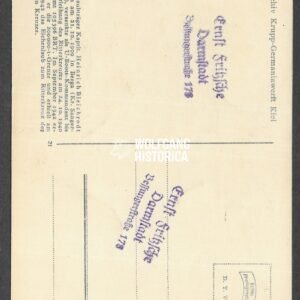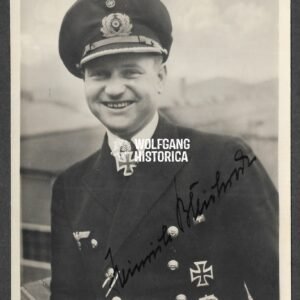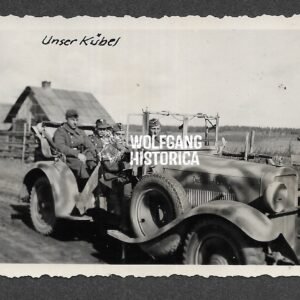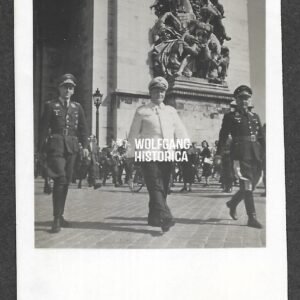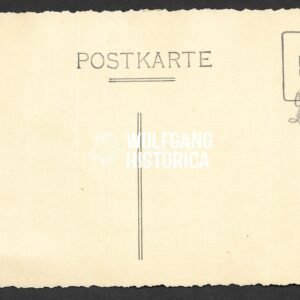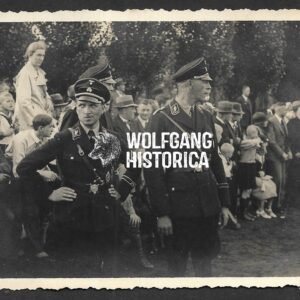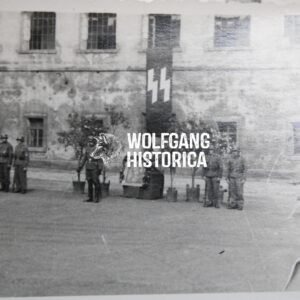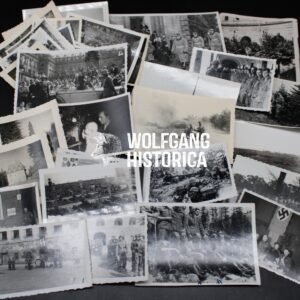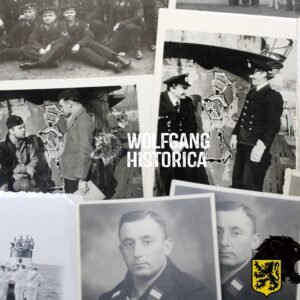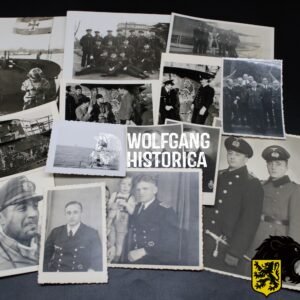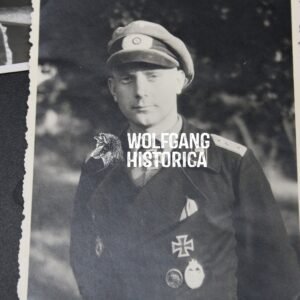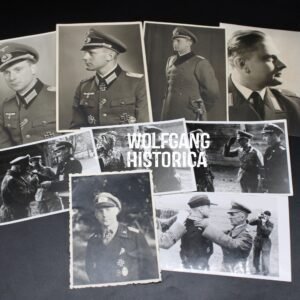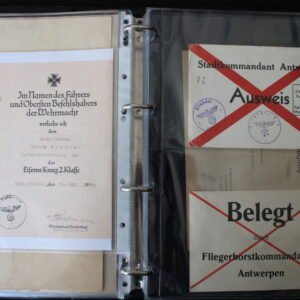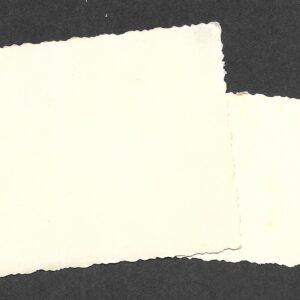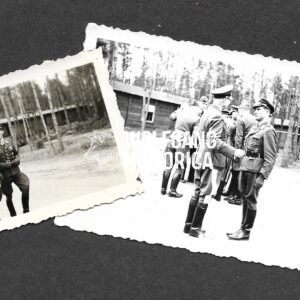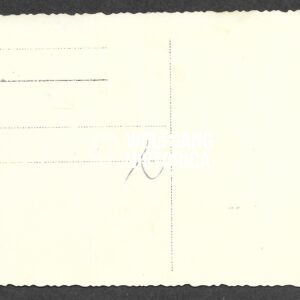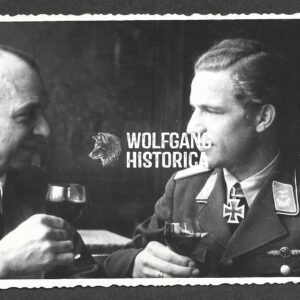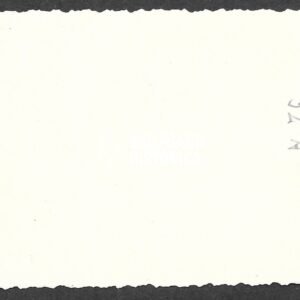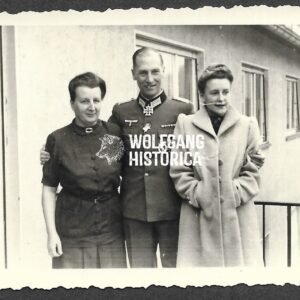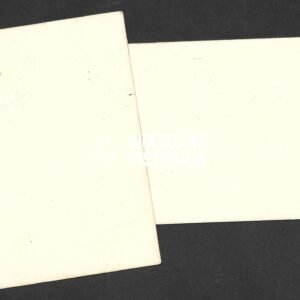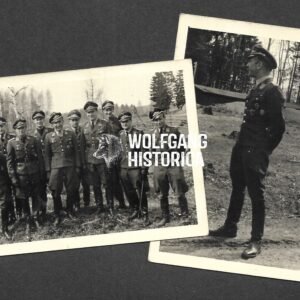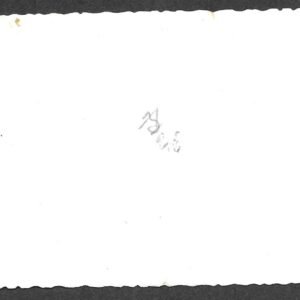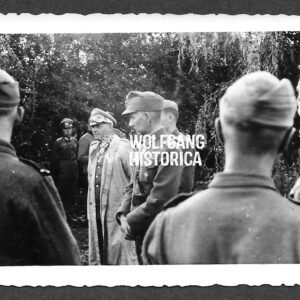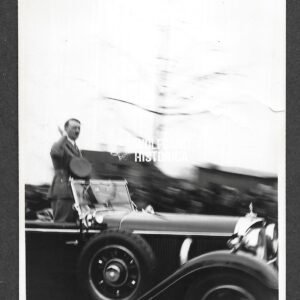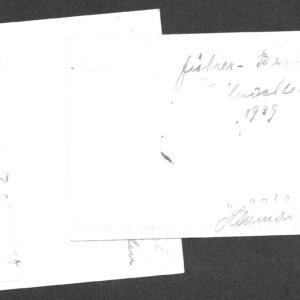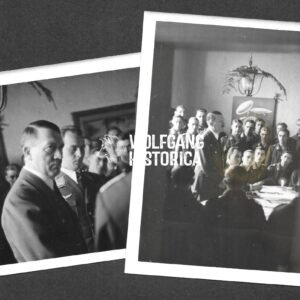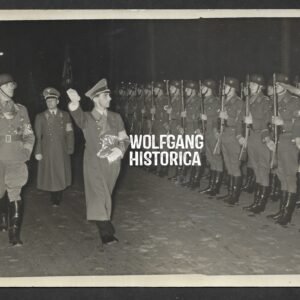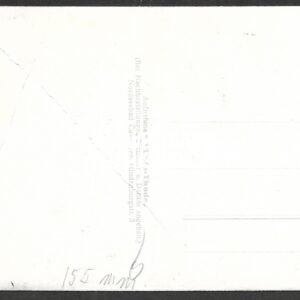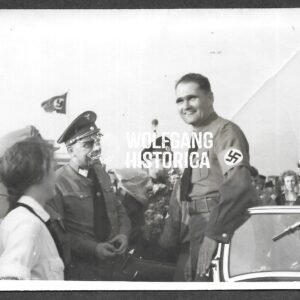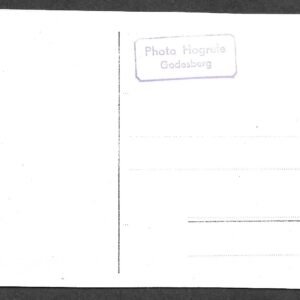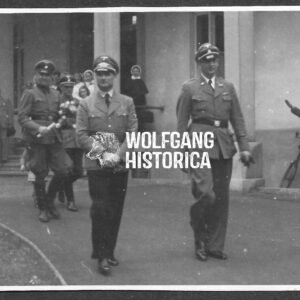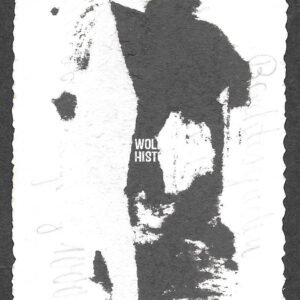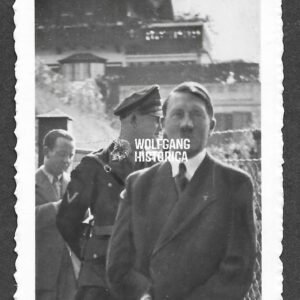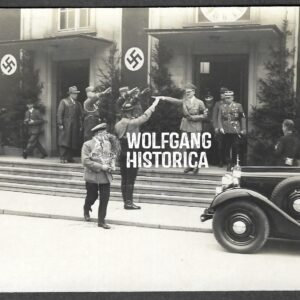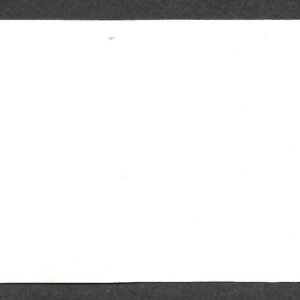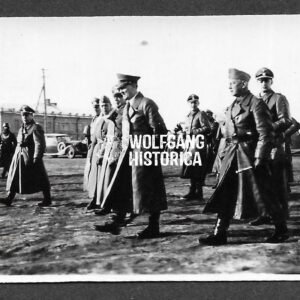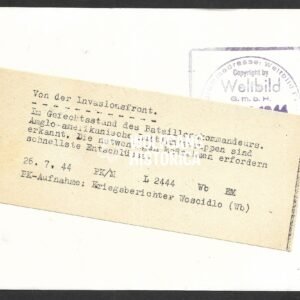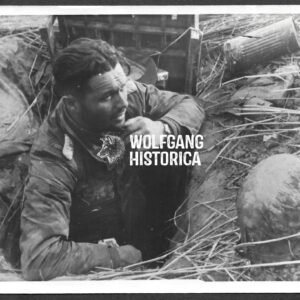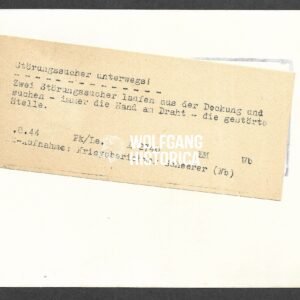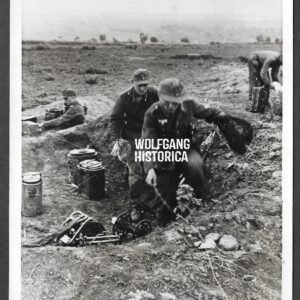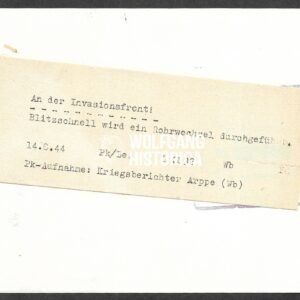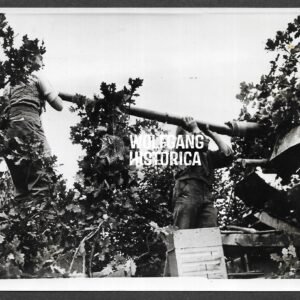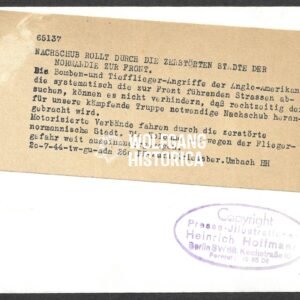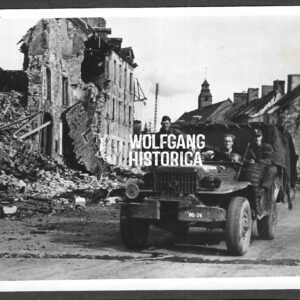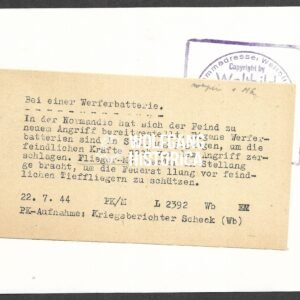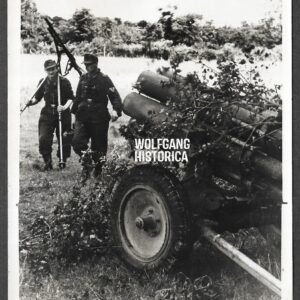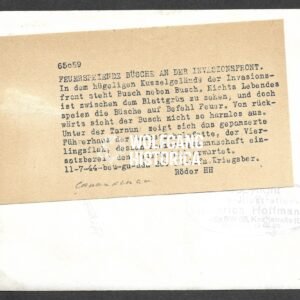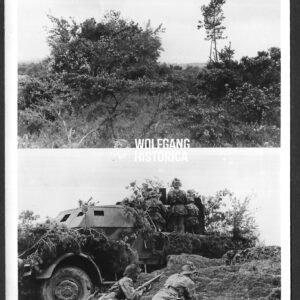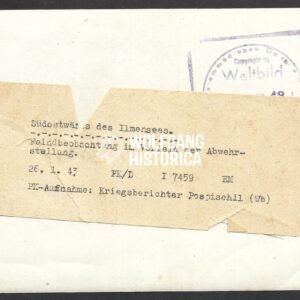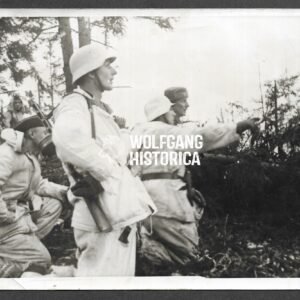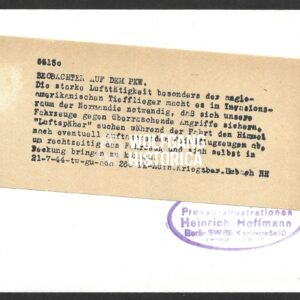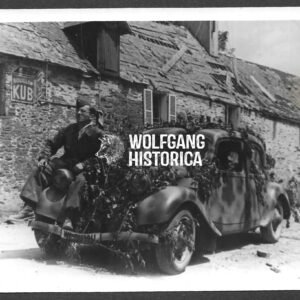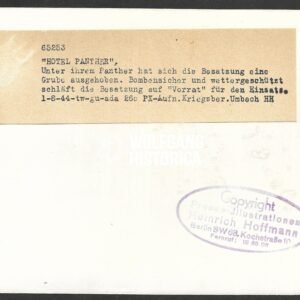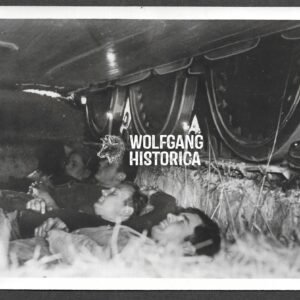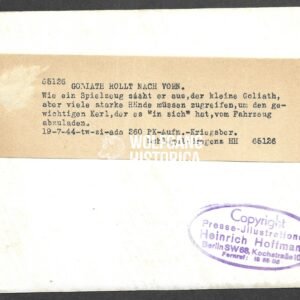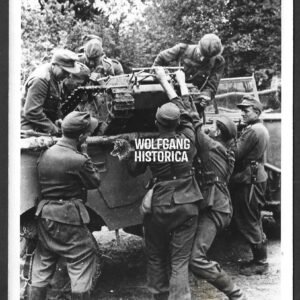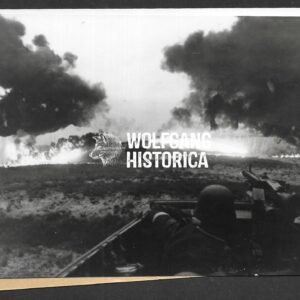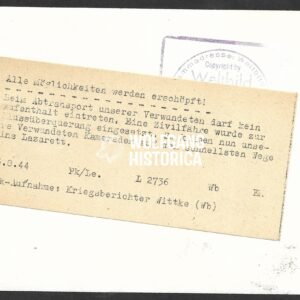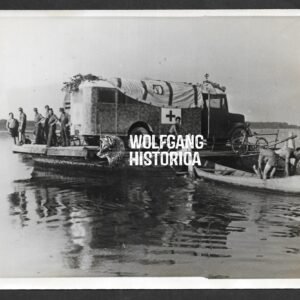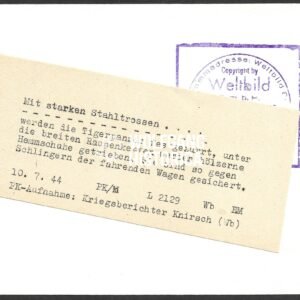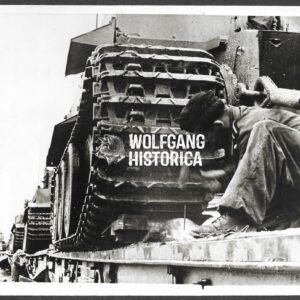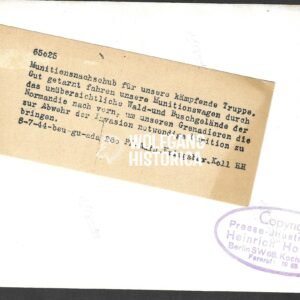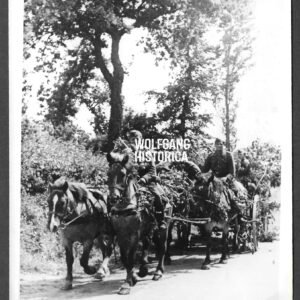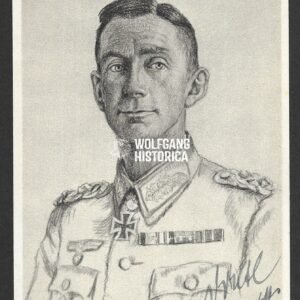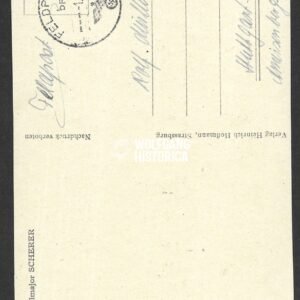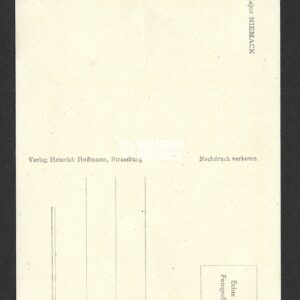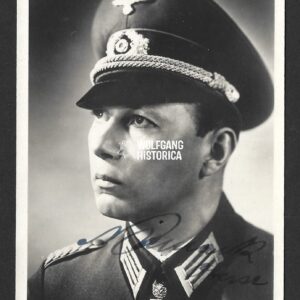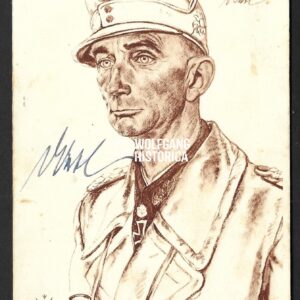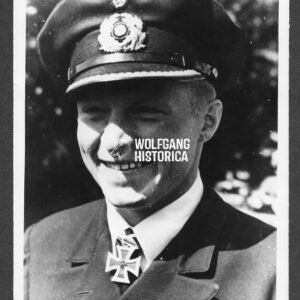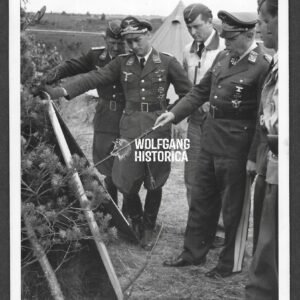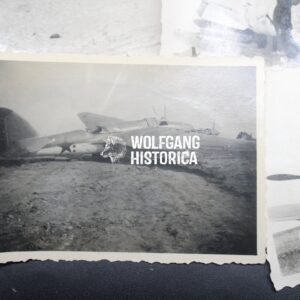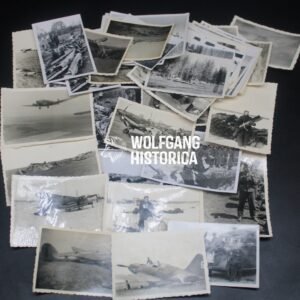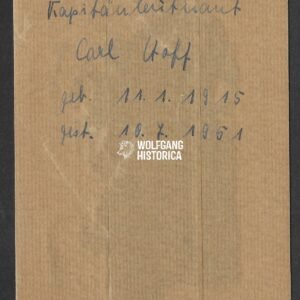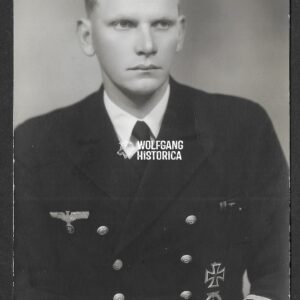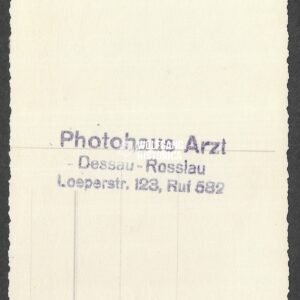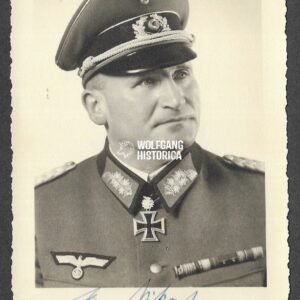Customers facing issues ordering, contact me
via info@wolfganghistorica.com or wolfganghistorica@gmail.com
NEW HOUTEN MILITARIA FAIR VIDEO ONLINE: Watch it here!
Heinrich Bleichrodt – “U-48” & “U-109” (Eichenlaub) (Wartime Signed)
€275,00Heinrich Bleichrodt (21 October 1909 † 9 January 1977) was a decorated German U-boat commander of the Second World War, serving with distinction during the Battle of the Atlantic. As commander of U-48 and later U-109, Bleichrodt achieved major successes against Allied shipping and became one of the Kriegsmarine’s leading U-boat aces.
Awards and Decorations
-
Knight’s Cross of the Iron Cross (Ritterkreuz des Eisernen Kreuzes) – 24 October 1940, as Kapitänleutnant and Kommandant of U-48.
-
Oak Leaves (Eichenlaub) – 23 September 1942, as Kapitänleutnant and Kommandant of U-109.
-
U-boat War Badge (U-Boots-Kriegsabzeichen).
-
Iron Cross (1939) 1st and 2nd Class.
Item Details
-
Original wartime signature of Kapitänleutnant Heinrich Bleichrodt.
-
Signed on a wartime postcard.
-
Provenance: From the large personal collection of HJ boy Ernst Fritzsche, who collected wartime autographs and correspondence during the period.
-
Condition: Good; postcard shows light age wear and trimmed edges from period handling. Signature remains bold and well-preserved.
Collector’s Note
Heinrich Bleichrodt ranks among the most successful U-boat commanders of the Kriegsmarine, credited with over 200,000 GRT of enemy shipping sunk. His autograph on wartime material is scarce and highly desirable, especially with traceable period provenance.
Photograph of Camo Wanderer W23 Kübel (?)
€25,00Original wartime photograph titled “Unser Kübel” (“Our Kübel”), showing a group of German Wehrmacht soldiers seated in a Wanderer W23 Kübelwagen (?) on a rural road, with farm buildings in the background. The vehicle, featuring field camouflage and distinctive front grille design, is characteristic of the early-war period.
Printed on period photo paper with scalloped edges and light silvering typical of 1940s prints. Excellent tonal contrast and clear detail; overall very good condition.
A fine and authentic field image depicting one of the less common pre-standardized Kübelwagen types used by German forces during the early stages of WWII.
Hermann Göring with Luftwaffe Officers, Paris, c. 1940
€35,00Original period photograph showing Reichsmarschall Hermann Göring walking with Luftwaffe officers in front of the Arc de Triomphe, Paris. The image captures Göring wearing a light-colored summer uniform, accompanied by officers in dark Luftwaffe dress. The monument’s sculptural relief (“La Marseillaise” by François Rude) is clearly visible in the background.
Printed on contemporary photo paper with white border. Light age toning and minor edge wear; overall very good condition with sharp contrast.
Photograph of Two High-Ranking Allgemeine SS Officers
€95,00This is an original vintage photograph, postcard-sized, depicting two unidentified high-ranking officers of the Allgemeine SS in full uniform. The image is sharp and well-composed, showing clear detail of insignia, medals, and uniform features typical of the pre-war SS organization.
Printed on period photographic paper with light age toning and minimal edge wear, this photograph remains in very good condition for its age.
A rare and historically significant image offering insight into SS leadership and uniform variations during the early Third Reich era.
Waffen-SS Mixed Photolot (LSSAH, Totenkopf, Camo Uniforms…)
€350,00Original wartime Waffen-SS photo lot consisting of 37 period photographs showing various units and personnel of the Waffen-SS in the field and on duty. The set features a wide variety of subjects and locations, offering a strong overview of SS front-line life during the Second World War.
Highlights include:
-
Totenkopf Division: several photos showing motorcycles with the Totenkopf insignia visible on the sidecar.
-
Leibstandarte “Adolf Hitler” Division: clear uniform views with cuff titles visible in multiple images.
-
Field scenes with soldiers in camouflage smocks and helmet covers, armed and in combat gear.
-
Group portraits, training shots, and informal snapshots, likely taken in occupied Europe and on the Eastern Front.
Uniform and equipment details visible throughout include field caps, M40 tunics, and SS-pattern camouflage garments, as well as vehicles and sidearms.
Historical Context:
The Waffen-SS represented the combat arm of the SS organization, and its divisions such as Totenkopf and Leibstandarte Adolf Hitler took part in major campaigns on both Eastern and Western fronts. These photographs document the uniforms, insignia, and conditions of those elite formations as they appeared during wartime.
Collector’s Note:
A substantial and varied grouping ideal for research or display, with strong photographic detail and divisional identifiers. Such mixed lots containing identifiable Totenkopf and Leibstandarte material are increasingly scarce.
Photo Grouping – U-Boat Crewman (U-48 – Most succesful U-Boat of WWII!)
€395,00Remarkable and diverse original photograph collection belonging to a Kriegsmarine U-Boat crew member, possibly of the famed U-48, the most successful German submarine of the Second World War. The set comprises 14 period photographs, showing the sailor’s career progression, service aboard a U-Boat, and several earlier images from his Imperial German Navy (WWI) service.
The highlight of the grouping are multiple photographs depicting U-Boat conning tower artwork and crew scenes on deck, including a clearly visible tower painting matching that of U-48 — the “laughing swordfish” motif associated with this legendary vessel. Several photos show officers and enlisted men posing beside the decorated U-Boat hull, along with portraits both in uniform and casual settings.
The remaining images document a rich personal and military history, featuring:
-
Crew group portraits taken both at sea and on land
-
Tower close-ups and harbor scenes, showing Kriegsmarine flags and deck fittings
-
Individual studio portraits in U-Boat dress uniforms, with badges and insignia visible
-
Earlier WWI-era naval photos, likely of the same man during his first period of service
Historical Context:
U-48 was commissioned in 1939 and became the most successful submarine of the Second World War, credited with sinking over 50 Allied ships (approximately 306,000 tons) before being scuttled in 1945. The presence of tower art and uniform details consistent with early-war Kriegsmarine U-Boat units strongly suggests these images relate to personnel of this elite vessel or one within its flotilla.
Collector’s Note:
Authentic U-Boat photographs — particularly those showing tower art — are exceptionally rare and highly sought after among Kriegsmarine collectors. This set offers not only identifiable imagery from an early and highly successful U-Boat but also a personalized service record across both World Wars, adding significant historical depth.
The prints are period originals on wartime photographic paper, several with studio stamps or annotations on reverse.
RARE Photograph Set – RKT Bernhard Klemz of Panzer-Regiment “Großdeutschland” (Wartime Signed!)
€850,00Exceptional set of 9x Total (7) original wartime and (2) postwar photographs of Hauptmann Bernhard Klemz (1918–2004), Knight’s Cross and German Cross in Gold recipient, commander of 5./Panzer-Regiment “Großdeutschland”. Several photographs bear period autographs and inscriptions on the reverse, dated 1943–1944, with one postwar signature from 1958. The set includes formal studio portraits in uniform as well as informal front photographs showing Klemz with fellow officers during field operations.
-
Knight’s Cross of the Iron Cross (Ritterkreuz des Eisernen Kreuzes)
-
German Cross in Gold (Deutsches Kreuz in Gold)
Historical Context:
Bernhard Klemz earned the Knight’s Cross on 4 June 1944 as Hauptmann und Chef 5.Kompanie/ Panzer-Regiment “Großdeutschland”, for decisive leadership during the battles near Târgu Frumos (Romania) in April 1944. Commanding 19 Panzer IVs, Klemz led a surprise attack on Soviet armoured concentrations, destroying twenty tanks and multiple artillery positions while sustaining minimal losses. His tactical success was later cited as a model example of mobile armoured warfare in the Eastern Front campaigns.
Klemz’s prior awards included the German Cross in Gold (10 February 1944), reflecting consistent excellence in command during operations in the East.
Collector’s Note:
This is a rare, cohesive photographic grouping connected to one of the notable Panzer officers of the “Großdeutschland” Division. The presence of multiple signed photographs, personal inscriptions, and clear period provenance make this set highly desirable for collectors of Knight’s Cross recipients, Panzertruppen memorabilia, or Großdeutschland Division history.
All prints exhibit sharp contrast and period authenticity — several showing studio backstamps or annotations from 1943–1944.
WWII Antwerp Flak & Wehrmacht Document and Photo Collection
€1.200,00An exceptional and historically significant World War II Luftwaffe and Wehrmacht collection centered around Antwerp, Belgium. This grouping includes numerous original wartime documents, photographs, and awards connected to personnel stationed in and around Antwerp and Deurne Airfield.
Contents include:
-
Flak Album (Antwerp) – Extensive photographic album featuring Luftwaffe Flak personnel, gun emplacements, anti-aircraft batteries, and group scenes in and around Antwerp. Includes action shots and unit photos, many captioned and dated.
-
Award Documents – Original citations for:
-
Iron Cross 2nd Class (Eisernes Kreuz 2. Klasse) awarded for shooting down an enemy aircraft.
-
Flak Badge (Flakkampfabzeichen) award document.
-
-
Photographs – Dozens of period photos showing Flak crews, heavy artillery positions, and daily life; also includes portraits taken in Antwerp and cemetery photos from Schoonselhof, where many German soldiers were buried.
-
Administrative & ID Documents –
-
Vehicle Ausweis (ID card) for parking and movement in German-occupied Antwerp.
-
"Belegt" window placard used to mark buildings requisitioned by the Luftwaffe near Antwerp-Deurne Airfield.
-
Official correspondence and letters (some signed and stamped) related to an officer at the Bataillonsführerschule Antwerp.
-
-
Additional materials –
-
Death card,
- Miscellaneous Wehrmacht and NSDAP papers, invitations, and wartime correspondence.
-
Highlights:
A rare, cohesive ensemble illustrating German operations in occupied Belgium. The documents and imagery together paint a vivid picture of the personnel, organization, and everyday life of an anti-aircraft unit stationed in Antwerp, one of the most strategic locations in Western Europe during WWII.
Condition:
All items are original WWII-period pieces, well preserved in archival sleeves within a binder. Documents show expected age-related toning; photographs remain crisp with excellent contrast.
2x Photos of Luftwaffe RKT Franz von Werra (Sole Pilot to escape from British Captivity to Germany!)
€130,00Pair of original wartime photographs depicting Luftwaffe officers in conversation and during an award or inspection ceremony, taken outdoors at a forest airfield or training camp, with wooden barracks visible in the background. The officer at the center is Franz von Werra, wearing a Luftwaffe flight tunic with decorations including the Knight’s Cross of the Iron Cross, Pilot’s Badge, and Iron Cross First Class.
The left image captures von Werra walking and conversing informally with a fellow officer, while the right photograph shows him in formation during what appears to be a decorations or commendation event, marked by the presence of senior officers and a formal salute.
Historical Context:
Franz von Werra (1914–1941) was one of the most famous Luftwaffe fighter aces and is best known as the only German pilot to successfully escape from British captivity and return to Germany during the Second World War. His exploits became legendary, later inspiring the 1957 British film The One That Got Away. Von Werra received the Knight’s Cross for his early wartime aerial victories with Jagdgeschwader 3 “Udet”, before his capture in 1940 and eventual death in a flying accident in 1941.
Collector’s Note:
These photographs, attributed to von Werra, are historically significant private images likely taken between 1940 and early 1941, providing a rare informal look at one of the Luftwaffe’s most publicized aces. Such photographs are highly desirable for collectors focusing on Luftwaffe history, early Knight’s Cross holders, or aviation escape narratives of the Second World War.
Luftwaffe Officer with Knight’s Cross – Unidentified Recipient
€95,00Original postcard-size photograph depicting a Luftwaffe officer wearing the Knight’s Cross of the Iron Cross (Ritterkreuz), seated at a table sharing a toast with a civilian companion. The officer’s uniform displays additional decorations, including the Pilot’s Badge and ribbon bar, indicating frontline flying service. The relaxed atmosphere and candid composition suggest the image was taken during a moment of rest or post-award celebration.
Historical Context:
The Knight’s Cross was one of the highest military awards of the Third Reich, recognizing exceptional bravery and leadership in combat. Luftwaffe officers who received it were often fighter aces, bomber commanders, or reconnaissance pilots distinguished by extraordinary achievement. Informal portraits like this one, taken outside the official propaganda framework, are comparatively rare, providing insight into the personal side of decorated officers away from the front.
Collector’s Note:
An excellent, high-quality wartime print of a Luftwaffe Knight’s Cross recipient in an intimate setting. While the officer’s identity remains undetermined, the sharp detail and visible decorations make this an appealing piece for collectors specializing in Luftwaffe or Knight’s Cross-related photography. The composition and expression convey a striking human moment amid wartime circumstances.
Condition: Superb contrast and clarity; light handling wear to edges.
Size: Approx. 9 × 14 cm (postcard format).
Photo of Unknown Knight’s Cross Recipient
€65,00Original wartime photograph depicting an unknown decorated German Army officer posing with two women, presumably family members, on a balcony outside a residential building. The officer wears a Wehrmacht field tunic adorned with multiple decorations, prominently including the Knight’s Cross of the Iron Cross, as well as additional badges and ribbon bars. The relaxed setting and informal composition suggest the image was taken during home leave or recuperation.
Historical Context:
Such personal photographs were often taken during brief visits home from the front, serving as cherished mementos for soldiers and their families. While formal portraits were common, informal family images like this offer a valuable glimpse into the private side of highly decorated officers, contrasting with the official propaganda imagery of the period.
Collector’s Note:
This is an authentic period photograph showing a Knight’s Cross holder in civilian surroundings—an uncommon subject among wartime personal snapshots. Its excellent tonal range and preservation make it a noteworthy piece for collectors of Wehrmacht or Knight’s Cross-related material, illustrating the intersection between military life and family identity during the war years.
Photographs of Luftwaffe RKT Theodor Weißenberger
€130,00Two original wartime photographs showing Luftwaffe officers in outdoor settings, posed informally in a wooded area. The left image depicts a group of fighter pilots and officers wearing flight uniforms and service caps, while the right image shows a single officer standing confidently with decorations clearly visible, including the Iron Cross and Pilot’s Badge.
The officer in the middle with RK is Theodor Weißenberger, a celebrated Luftwaffe fighter ace credited with over 200 aerial victories and recipient of the Knight’s Cross of the Iron Cross with Oak Leaves and Swords. Weißenberger served with Jagdgeschwader 5 (JG 5 “Eismeer”) and later commanded JG 7, Germany’s first operational jet fighter wing.
Historical Context:
Photographs of this type were often taken during unit postings or brief rest periods on northern or Eastern Front airfields. They provide a glimpse into the camaraderie and personality of Luftwaffe officers during the height of aerial operations in the later years of the war. Images featuring high-ranking or decorated pilots are especially valued for their connection to the Luftwaffe’s elite fighter groups and the documentation of their wartime environment.
Collector’s Note:
This is a rare, authentic pair of private photographs attributed to one of Germany’s most noted fighter aces. Such informal wartime portraits offer an invaluable window into the daily life and esprit de corps among Luftwaffe pilots. A desirable addition for collectors of Luftwaffe history, aviation photography, and Knight’s Cross-related material.
Photograph of Waffen-SS Officer Felix Steiner in Field Discussion
€125,00Original wartime photograph showing a group of Waffen-SS and Wehrmacht officers gathered in discussion in an outdoor setting, likely during operations on the Eastern Front. The central figure, collector-attributed as SS-Gruppenführer Felix Steiner, can be seen wearing a Knight’s Cross (Ritterkreuz) around his neck, speaking with field officers in standard combat attire. Several soldiers stand nearby, listening attentively, indicating a briefing or inspection taking place close to the front.
Historical Context:
Wartime photographs such as this were often taken during command conferences or morale visits, documenting coordination between Waffen-SS field units and Army elements. By mid-1944, senior Waffen-SS officers frequently appeared at the front to review units engaged in the increasingly defensive battles on the Eastern Front. Such moments were sometimes photographed by Propaganda Kompanie correspondents or unit photographers for internal record and propaganda use.
Collector’s Note:
This photograph is a striking field image capturing the atmosphere of senior command within Waffen-SS formations during the later stages of the war. The collector’s attribution to Felix Steiner adds interest for those studying the structure and leadership of German armored and infantry formations. Original prints depicting identifiable high-ranking officers are valued for their documentary and research significance.
Photograph of Adolf Hitler in his Car
€45,00Original period photograph of Adolf Hitler, depicting a uniformed figure standing in an open staff car, waving to a crowd during a parade or public appearance. The vehicle appears to be a Mercedes-Benz 770K “Großer Mercedes”, the model commonly used by senior German officials during state events and propaganda tours. The motion blur and spontaneous composition suggest this image was captured by an onlooker or press photographer as the motorcade passed.
Collector’s Note:
This photograph is a striking candid image that captures the dynamic energy of official appearances in the 1930s–1940s. Its sharp depiction of the iconic parade car and blurred backdrop of cheering spectators convey the movement and orchestrated spectacle typical of such events. A valuable piece for historians and collectors studying the visual culture and propaganda mechanics of the period.
2x Photos of Adolf Hitler Visiting Luftwaffe Personnel
€120,00Set of two original wartime photographs, collector-attributed to depict Adolf Hitler visiting Luftwaffe personnel at what appears to be an air base or officers’ mess. The images show a group of uniformed Luftwaffe officers and enlisted men gathered closely indoors, listening intently as the central figure addresses them. The relaxed yet formal atmosphere suggests an inspection or morale visit typical of late-war photo documentation.
Collector’s Note:
These photographs are rare private images, showing the intimate, behind-the-scenes atmosphere of official visits rather than large-scale public rallies. The informal composition, the presence of attentive Luftwaffe officers, and the subdued setting all contribute to their documentary value. As authentic period prints, they represent visual evidence of the interplay between political symbolism and military life within the Third Reich.
German Press Photo – Goebbels at the “Tagung der Reichspropagandisten,” Berlin, 23 November 1938
€125,00Original press photograph showing Dr. Joseph Goebbels during an official inspection or ceremonial review of SA and SS troops, taken during the conference of Reich propagandists (Tagung der Reichspropagandisten) in Berlin on 23 November 1938. Goebbels is seen saluting as he passes a formation of uniformed soldiers standing at attention, accompanied by senior officers and aides.
The verso bears typed and handwritten annotations identifying the event and date, as well as official stamps from the “Deutscher Verlag Bilder-Zentrale”, the central photographic press service of the Nazi state.
Historical Context:
The photograph dates to just weeks after the Kristallnacht pogrom (9–10 November 1938), a period during which Goebbels, as Reich Minister of Propaganda, intensified his control over German media and public messaging. Events such as this propaganda conference were organized to coordinate ideological instruction among regional propaganda leaders and maintain regime unity in the wake of international condemnation of Nazi policies.
Collector’s Note:
This is an authentic Third Reich press photograph issued through official channels, complete with period stamps and handwritten description. Its excellent clarity and provenance from the Deutscher Verlag agency make it a valuable example of early National Socialist propaganda documentation. Such photos were distributed in limited quantities to state-controlled newspapers and magazines for publication.
Condition: Very good; light handling wear and minor creasing.
Size: Approx. 18 × 13 cm.
Verso Markings: “Deutscher Verlag Bilder-Zentrale” press stamps, handwritten event note “Dr. Goebbels vor der Ehrendienstigung bei der Tagung der Reichspropagandisten, 23.11.38.”
RARE Photo of RUDOLF HESS Greeting at a Public Event
€175,00Original rare wartime photograph depicting Rudolf Hess standing in an open car during what appears to be a public gathering or rally. Several NSDAP officers and BDM girls are seen nearby, welcoming the official with flowers. A swastika flag is visible in the background along with crowds of onlookers. The image likely dates to the late 1930s or early 1940s, typical of propaganda-style event photography of the time.
-
Location: Unidentified (likely within Germany)
-
Size: Postcardsize
-
Condition: Excellent tonal quality and detail; light handling wear consistent with age.
Historical Context:
Rudolf Hess (1894–1987) served as Deputy Führer of the National Socialist German Workers’ Party (NSDAP) until 1941. Known as one of Adolf Hitler’s earliest followers, Hess played a significant administrative and ideological role within the Nazi regime. Images such as this were produced to reinforce the cult of leadership and unity central to National Socialist propaganda. His later flight to Scotland in 1941, in an attempt to negotiate peace with Britain, resulted in his imprisonment for the remainder of World War II.
RARE Photo of RUDOLF HESS during Official Visit – 19 June 1940
€150,00Original rare wartime photograph showing Rudolf Hess, Stellvertreter des Führers (Deputy Führer of the NSDAP), during an official visit on 19 June 1940. Hess is seen walking from a building, accompanied by senior SS and Party officers, with children, nuns, and civilians present — suggesting a ceremonial or morale event at a local institution. One officer carries a bouquet of flowers, emphasizing the formal nature of the occasion.
The photograph captures the confident atmosphere in Germany following the armistice with France, during one of Hess’s last major public appearances before his 1941 flight to Scotland.
-
Date: 19 June 1940
-
Location: Unidentified (likely within Germany)
-
Size: Postcardsize
-
Condition: Excellent tonal quality and detail; light handling wear consistent with age.
Historical Context
Rudolf Hess (1894–1987) served as Deputy Führer of the NSDAP and was one of Adolf Hitler’s earliest and most trusted associates. In June 1940, following the capitulation of France, Hess took part in numerous public visits and symbolic ceremonies across Germany — moments widely used by the Heinrich Hoffmann press office for propaganda purposes, emphasizing unity and triumph after the campaign in the West.
Collector’s Note
A rare and historically important original photograph of Rudolf Hess, taken during the height of Nazi Germany’s wartime success. Excellent composition and atmosphere, showing Hess in uniform amid civilians and SS personnel. A desirable addition for collectors of Third Reich leadership, Heinrich Hoffmann press photography, and wartime ceremonial imagery.
Adolf Hitler at Berchtesgaden / Obersalzberg
€75,00Original wartime-era photograph depicting Adolf Hitler standing outdoors in civilian attire, likely within the grounds of his Obersalzberg residence near Berchtesgaden, Bavaria. Behind him are an SS orderly in uniform and a civilian aide, typical of the small personal entourage present during informal moments at the Berghof. The architectural style of the background building, wooden fencing, and alpine slope are consistent with known Obersalzberg structures from the mid-1930s period.
- Location: Obersalzberg / Berchtesgaden
-
Size: approx. 9 × 6 cm
-
Condition: Excellent contrast; minimal age wear; original photo-paper with scalloped edges.
Historical Context
The Berghof, located on the Obersalzberg above Berchtesgaden, served as Adolf Hitler’s private retreat and secondary seat of power. Many informal photographs and newsreels from the era show Hitler receiving guests, walking the grounds, or engaging in casual moments with his SS staff and aides. Such private or semi-official images were often taken by Heinrich Hoffmann’s studio photographers or accompanying propaganda staff.
Collector’s Note
An authentic and uncommon original photograph showing Adolf Hitler at his mountain residence, surrounded by SS personnel and staff — a characteristic scene of the pre-war Obersalzberg period. These candid civilian-attire photos are much scarcer than formal portraits or military inspection images and represent a highly desirable addition to collections focused on Third Reich leadership, the Obersalzberg complex, or early Nazi propaganda imagery.
Adolf Hitler and Entourage at Official Reception with Führer Car
€95,00Original wartime photograph showing Adolf Hitler during an official event or reception, standing before a prominently decorated government or party building adorned with swastika banners and the Reichsadler emblem. Hitler is seen accompanied by senior Wehrmacht and SS officers, while his official Mercedes staff car waits in the foreground, attended by SS drivers and adjutants.
The image captures the moment of formal greeting and salute exchange, typical of high-level state or military visits in the late 1930s. Several SS officers and uniformed personnel can be seen performing the Hitler salute, emphasizing the ceremonial nature of the occasion.
-
Date: ca. 1938–1939
-
Location: Likely Berlin or Munich
-
Size: Postcardsize
-
Condition: Excellent contrast and detail; light handling wear consistent with age; finely preserved original photograph.
Historical Context
Such official receptions were a hallmark of the Nazi leadership’s public appearances, often documented by the Heinrich Hoffmann press agency for propaganda and state archives. Hitler’s personal car, identifiable by its distinct design and SS escort, was frequently photographed during these ceremonial arrivals and departures.
Collector’s Note
A rare and historically important original photograph depicting Adolf Hitler with his official car and SS escort, taken during a pre-war state or party event. Rich in period detail, this is an outstanding addition for collectors of Third Reich leadership imagery, Heinrich Hoffmann press photography, or Führer motorcade documentation.
Adolf Hitler with Waffen-SS Officers and GFM Erich von Manstein (?)
€45,00Original wartime photograph depicting Adolf Hitler accompanied by senior Waffen-SS officers and likely Generalfeldmarschall Erich von Manstein during a frontline visit or command inspection. The group is dressed in field and leather greatcoats, with accompanying adjutants and security personnel in the background. Staff vehicles and military buildings are visible behind them.
-
Date: ca. 1942–1943
-
Size: approx. 9 × 6.5 cm
-
Condition: Very good. Light handling wear consistent with age; strong contrast and clarity.
Historical Context
This photograph likely captures one of Hitler’s field visits to inspect front-line positions and confer with senior command staff during key Eastern Front operations. Such visits were rare and tightly controlled, often involving high-ranking Heer and Waffen-SS leaders, including commanders like von Manstein, who played a central role in the campaigns in southern Russia and the Crimea.
The presence of Waffen-SS officers alongside Hitler highlights the growing prominence of SS formations in major operations by mid-war, as well as their close coordination with army command structures.
Collector’s Note
A striking and historically important original photograph featuring Adolf Hitler in the field with senior Waffen-SS and Wehrmacht leadership—possibly including Feldmarschall Erich von Manstein. Such images, particularly from Eastern Front inspections, are rare and highly sought after by collectors of Third Reich leadership, command photography, and Hitler’s wartime visits.
An exceptional addition to any advanced collection of WWII Führerbesuche, Waffen-SS, or Eastern Front photographic material.
German Press Photo – Ritterkreuzträger Hans Waldmüller, 12. SS-Panzer-Division “Hitlerjugend” (Normandy 1944)
€250,00Original wartime press photograph showing Hans Waldmüller, holder of the Knight’s Cross of the Iron Cross (Ritterkreuz des Eisernen Kreuzes), serving as a battalion commander in the 12. SS-Panzer-Division “Hitlerjugend” during the fighting in Normandy, July 1944. The reverse bears the original typed German caption:
“Von der Invasionsfront. Im Gefechtsstand des Bataillonskommandeurs. Anglo-amerikanische Luftlandetruppen sind erkannt. Die notwendigen Maßnahmen erfordern schnellste Entschlüsse.”
(From the Invasion Front. In the command post of the battalion commander. Anglo-American airborne troops have been identified. Immediate decisions are required.)
-
Date: 26 July 1944
-
Photographer / PK Unit: Kriegsberichter Woscidlo (Wb)
-
Agency Stamp: Weltbild GmbH (on reverse)
-
Caption Code: L 2444 / PK/M
-
Size: approx. 18 × 13 cm
-
Condition: Excellent – minor edge wear, fully intact typed caption, clear agency stamp.
Historical Context
Hans Waldmüller (1912–1944) was a decorated officer of the 12. SS-Panzer-Division “Hitlerjugend”, awarded the Ritterkreuz des Eisernen Kreuzes for bravery in battle. During the Normandy campaign, he commanded a battalion within the division, playing a key role in the German defense against Allied landings. After the war, Waldmüller was murdered by resistance members in 1944, adding a tragic coda to his distinguished military career.
Collector’s Note
This is a rare and historically significant photograph, capturing a Knight’s Cross recipient of the elite 12. SS “Hitlerjugend” Division in Normandy during the height of the campaign. With original Weltbild stamp and full caption identifying the scene at the “Invasionsfront,” this piece represents an exceptional addition to any advanced collection of WWII Waffen-SS, Normandy, or Ritterkreuzträger memorabilia.
German Press Photo – “Grossdeutschland” Signal Troops Repairing Communication Lines, March 1944
€75,00Original wartime German press photograph showing Wehrmacht "Grossdeutschland" signal troops (“Störungssucher”) repairing damaged telephone lines at the front. The caption describes two men venturing from cover, tracing the wire by hand to locate the break in communications — an essential yet dangerous task on the battlefield.
Reverse caption reads:
“Störungssucher unterwegs! Zwei Störungssucher laufen aus der Deckung und suchen – immer die Hand am Draht – die gestörte Stelle.”
(Line repairmen on the move! Two signalmen leave cover, searching with their hands along the wire to find the damaged section.)
-
Date: March 1944
-
Photographer / PK Unit: Kriegsberichter Scheerer (Wb)
-
Caption Code: L 2740 Wb EM
-
Agency Stamp: Weltbild Presseservice, Frankfurt am Main (on reverse)
-
Size: approx. 18 × 13 cm
-
Condition: Excellent – full typed caption slip intact, light toning and handling consistent with wartime origin.
Historical Context
Signal and communication troops were vital to maintaining command and control across the front lines. During heavy bombardments, communication lines were frequently severed, forcing these men — often under fire — to move across open terrain to restore links. This photograph captures that dangerous but often overlooked aspect of Wehrmacht field operations.
Collector’s Note
An authentic Weltbild press photograph illustrating the crucial role of Nachrichtentruppe (signal troops) in maintaining battlefield communication. Complete with original caption and agency mark, this is an excellent addition for collectors of Eastern Front, field operations, and propaganda photography.
German Press Photo – Quick Barrel Change at the Invasion Front, June 1944
€95,00Original wartime German press photograph taken at the Normandy invasion front, showing German troops performing a rapid barrel change (“Rohrwechsel”) under combat conditions. The concise caption emphasizes speed and efficiency under pressure — a reflection of German propaganda focusing on discipline and technical skill during the desperate defensive battles of June 1944.
Reverse caption reads:
“An der Invasionsfront! Blitzschnell wird ein Rohrwechsel durchgeführt.”
(At the invasion front! A barrel change is carried out at lightning speed.)
-
Date: 14 June 1944
-
Photographer / PK Unit: Kriegsberichter Arppe (Wb)
-
Caption Code: L 2892 Wb Ei
-
Agency Stamp: Weltbild Presseservice, Frankfurt am Main (on reverse)
-
Size: approx. 18 × 13 cm
-
Condition: Excellent – intact typed caption label, minimal age wear, original wartime issue.
Historical Context
Taken in June 1944, shortly after the Allied landings in Normandy, this image documents German front-line maintenance activity amid the intense fighting following D-Day. Rapid gun barrel changes were critical to keeping artillery and anti-tank weapons operational under continuous engagement, particularly as Allied forces pushed inland.
Collector’s Note
An authentic Weltbild press photo from the Normandy invasion period, complete with its original caption. Such succinctly titled photos (“An der Invasionsfront!”) are among the most desirable Normandy press issues, representing the immediacy and tension of the front-line experience. Perfect for collectors of Wehrmacht field operations and propaganda photography.
German Press Photo – Supply Convoy through the Ruins of Normandy, July 1944
€85,00Original wartime German press photograph showing motorized Wehrmacht supply units moving through a bombed-out Norman town to deliver much-needed ammunition and provisions to the front. Despite constant Allied air attacks and the destruction of transport routes, the caption emphasizes the continued effort to maintain the German supply chain under fire.
Reverse caption reads:
“Nachschub rollt durch die zerstörten Städte der Normandie zur Front. Die Bomben- und Tiefflieger-Angriffe der Anglo-Amerikaner, die systematisch die zur Front führenden Straßen absuchen, können es nicht verhindern, daß rechtzeitig der für unsere kämpfende Truppe notwendige Nachschub herangebracht wird. Motorisierte Verbände fahren durch die zerstörte normannische Stadt. Die Kolonne ist wegen der Fliegergefahr weit auseinandergezogen.”
(Supply rolls through the destroyed towns of Normandy to the front. The bombing and low-level attacks by the Anglo-Americans, who systematically scour the roads leading to the front, cannot prevent the timely delivery of essential supplies to our fighting troops. Motorized columns drive through the shattered Norman town, spread out due to the danger from aircraft.)
-
Caption Code: 65137
-
Date: 20 July 1944
-
Photographer / PK Unit: Kriegsberichter Umbach, 260 PK-Aufnahme
-
Agency Stamp: Heinrich Hoffmann, Presse-Illustrationen, Berlin SW68 (on reverse)
-
Size: approx. 18 × 13 cm
-
Condition: Excellent – full typed caption label intact, clear Hoffmann agency stamp, minor period handling traces.
Historical Context
This photograph, taken during the Normandy Campaign, documents the logistical challenges faced by the Wehrmacht amid relentless Allied air supremacy. As German forces struggled to maintain supply lines through bombed-out towns and destroyed infrastructure, propaganda images like this underscored endurance and determination in the face of defeat.
Collector’s Note
An authentic and visually evocative Heinrich Hoffmann press photo from Normandy 1944, complete with original typed caption. Excellent provenance and a striking example of late-war German propaganda photography, ideal for collectors of Wehrmacht operations and Western Front imagery.
German Press Photo – Nebelwerfer Battery in Action, Normandy 1944
€100,00Original wartime German press photograph showing a Werfer (rocket launcher) battery of the Wehrmacht on the Normandy front, preparing to counter an expected Allied attack. The detailed caption describes how German Nebelwerfer crews took up positions to strike at advancing enemy forces before their offensive began, while Flieger-MG (anti-aircraft machine guns) were positioned to defend the battery against Allied fighter-bombers.
Reverse caption reads:
“Bei einer Werferbatterie. In der Normandie hat sich der Feind zu neuem Angriff bereitgestellt. Eigene Werferbatterien sind in Stellung gegangen, um die feindlichen Kräfte noch vor dem Angriff zu zerschlagen. Flieger-MG werden in Stellung gebracht, um die Feuerstellung vor feindlichen Tieffliegern zu schützen.”
(At a rocket battery. In Normandy, the enemy has prepared for a new attack. Our own rocket batteries have taken up position to smash enemy forces before their assault begins. Anti-aircraft machine guns are set up to protect the launch positions from low-flying enemy aircraft.)
-
Date: 22 July 1944
-
Photographer / PK Unit: Kriegsberichter Scheck (Wb)
-
Caption Code: L 2392 Wb EM
-
Agency Stamp: Weltbild Presseservice, Frankfurt am Main (on reverse)
-
Size: approx. 18 × 13 cm
-
Condition: Excellent – original typed caption slip intact, light handling consistent with wartime use.
Historical Context
Taken during the Normandy Campaign, this image documents the deployment of Nebelwerfer rocket batteries, among the most feared German artillery weapons of the war. Their distinctive shrieking sound earned them the Allied nickname “Screaming Meemies.” These batteries were critical in providing heavy fire support and counter-battery fire during the desperate defensive battles of summer 1944.
Collector’s Note
A fine and authentic Weltbild press photo capturing one of the iconic weapons of the German army — the Nebelwerfer. With its complete typed caption and period agency stamp, this photograph offers excellent provenance and is ideal for collectors focused on German artillery, Normandy operations, or WWII propaganda photography.
German Press Photo – “Fire-Spitting Bushes” at the Invasion Front, July 1944
€125,00Original wartime German press photograph showing camouflaged anti-aircraft positions hidden within the dense hedgerow terrain of the Normandy front. The caption, titled “Feuerspeiende Büsche an der Invasionsfront” (“Fire-Spitting Bushes at the Invasion Front”), vividly describes the deception of the landscape — where seemingly harmless bushes conceal deadly gun positions ready to open fire.
Reverse caption reads:
“In dem hügeligen Kusselgelände der Invasionsfront steht Busch neben Busch. Nichts Lebendes ist zwischen dem Blattgrün zu sehen, und doch speien die Büsche auf Befehl Feuer. Von rückwärts sieht der Busch nicht so harmlos aus. Unter der Tarnung zeigt sich das gepanzerte Führerhaus der Selbstfahrlafette, der Vierlingsflak, dessen Bedienungsmannschaft einsatzbereit den Feuerbefehl erwartet.”
(In the hilly terrain of the invasion front, bush stands beside bush. Nothing living can be seen between the greenery — yet on command, the bushes spit fire. From behind, the harmless-looking foliage reveals the armored cabin of a self-propelled anti-aircraft gun, its crew standing ready for the order to open fire.)
-
Caption Code: 65059
-
Date: 11 July 1944
-
Photographer / PK Unit: Kriegsberichter Röder, 260 PK-Aufnahme
-
Agency Stamp: Heinrich Hoffmann, Presse-Illustrationen, Berlin SW68 (on reverse)
-
Size: approx. 18 × 13 cm
-
Condition: Excellent – original typed caption label intact, light period wear, clear Hoffmann agency stamp.
Historical Context
Taken during the Normandy Campaign following the Allied landings, this image reflects German efforts to conceal Flak and anti-tank positions within the bocage countryside. The evocative caption title “Fire-Spitting Bushes” served as propaganda to emphasize both German ingenuity and resistance against overwhelming Allied air and ground forces.
Collector’s Note
A dramatic and well-documented Heinrich Hoffmann press photo, offering insight into the camouflage and defensive tactics of German forces during the 1944 Normandy fighting. Complete with its full typed caption slip and Hoffmann stamp, this is a fine and collectible example of authentic WWII propaganda imagery.
German Press Photo – Enemy Observation Southeast of Lake Ilmen, January 1943
€75,00Original wartime German press photograph depicting enemy observation activities southeast of Lake Ilmen (Ilmensee) on the Eastern Front. The accompanying caption describes front-line reconnaissance work in the forward defensive sector, a crucial element of German operations in the harsh winter of 1942–43.
Reverse caption reads:
“Südostwärts des Ilmensees. Feindbeobachtung im Vorfeld der Abwehrstellung.”
(Southeast of Lake Ilmen. Enemy observation in front of the defensive positions.)
-
Date: 26 January 1943
-
Photographer / PK Unit: Kriegsberichter Pospischil (Wb)
-
Caption Code: I 7459 EM
-
Agency Stamp: Weltbild Presseservice, Frankfurt am Main (on reverse)
-
Size: approx. 18 × 13 cm
-
Condition: Good – intact typed caption slip, light creasing and age wear consistent with wartime handling.
Historical Context
This photograph was taken during the winter fighting around Lake Ilmen, a key sector of the Northern Front south of Leningrad. The area was the site of continuous engagements between German and Soviet forces, with reconnaissance and observation playing vital roles in the defensive struggle of early 1943.
Collector’s Note
An atmospheric Weltbild Eastern Front press photograph, offering a glimpse into daily Wehrmacht operations during the bitter winter of 1942–43. The combination of precise geographic reference (“southeast of Ilmensee”) and intact period caption makes this a valuable piece for collectors of Eastern Front photography and wartime propaganda material.
German Press Photo – Observers on Vehicle Watch for Allied Aircraft, Normandy 1944
€100,00Original wartime German press photograph showing a Luftspäher (air observer) on a Wehrmacht vehicle scanning the skies for low-flying Allied aircraft during the Normandy campaign. The caption describes how German vehicles took extra precautions against sudden air attacks from Allied fighter-bombers that dominated the skies in the summer of 1944.
Reverse caption reads:
“Beobachter auf dem Pkw. Die starke Lufttätigkeit besonders der anglo-amerikanischen Tiefflieger macht es im Invasionsraum der Normandie notwendig, daß sich unsere Fahrzeuge gegen überraschende Angriffe sichern. ‘Luftspäher’ suchen während der Fahrt den Himmel nach eventuell auftauchenden Feindflugzeugen ab, um rechtzeitig das Fahrzeug und sich selbst in Deckung bringen zu können.”
(Observers on the car. The intense air activity, especially from Anglo-American low-flying aircraft, makes it necessary in the invasion area of Normandy for our vehicles to protect themselves against surprise attacks. ‘Air spotters’ scan the sky during movement to detect enemy planes in time and take cover.)
-
Caption Code: 65180
-
Date: 21 July 1944
-
Photographer / PK Unit: Kriegsberichter Umbach, 260 PK-Aufnahme
-
Agency Stamp: Heinrich Hoffmann, Presse-Illustrationen, Berlin SW68 (on reverse)
-
Size: approx. 18 × 13 cm
-
Condition: Very good – original typed caption label intact, light handling and period toning consistent with age.
Historical Context
Captured during the Normandy Campaign (July 1944), this photo reflects the growing threat posed by Allied air superiority. As German ground units retreated under near-constant air attacks, “Luftspäher” were deployed on vehicles to provide early warning, a vivid reminder of the Luftwaffe’s diminishing control of the skies.
Collector’s Note
An authentic Heinrich Hoffmann press photograph from the Normandy front, combining technical and human interest. The detailed caption provides insight into German defensive adaptations against Allied air dominance. A strong and atmospheric addition to any Wehrmacht or Normandy 1944 photo collection.
German Press Photo – “Hotel Panther”, Normandy 1944
€85,00Original wartime German press photograph showing a Panther tank crew resting in a makeshift dugout under their vehicle. The typed caption humorously refers to this field shelter as “Hotel Panther,” emphasizing the soldiers’ improvisation and endurance during the campaign in Normandy.
Reverse caption reads:
“‘Hotel Panther’. Unter ihrem Panther hat sich die Besatzung eine Grube ausgehoben. Bombensicher und wettergeschützt schläft die Besatzung auf ‘Vorrat’ für den Einsatz.”
(‘Hotel Panther’. Beneath their Panther, the crew has dug a pit. Bombproof and weather-protected, the crew sleeps in reserve, ready for the next mission.)
-
Caption Code: 65253
-
Date: 1 August 1944
-
Photographer / PK Unit: Kriegsberichter Umbach, 260 PK-Aufnahme
-
Agency Stamp: Heinrich Hoffmann, Presse-Illustrationen, Berlin SW68 (on reverse)
-
Size: approx. 18 × 13 cm
-
Condition: Very good – complete typed caption slip, clear Hoffmann agency stamp, minor handling consistent with period use.
Historical Context
Photographed in August 1944, during the Battle of Normandy, this image captures the daily realities of German Panther crews as they sought shelter from air attacks and artillery fire. The lighthearted caption “Hotel Panther” reflects wartime propaganda’s effort to portray German soldiers as resilient and resourceful even amid dire circumstances.
Collector’s Note
An appealing and atmospheric Heinrich Hoffmann press photo featuring one of the Wehrmacht’s most iconic tanks, the Panther. Original wartime images with complete captions and Hoffmann provenance are increasingly scarce and highly collectible, especially those offering insight into the human side of armored warfare.
German Press Photo – Goliath Remote-Controlled Demolition Vehicle, July 1944
€150,00Original wartime German press photograph showing the Sd.Kfz. 302/303 “Goliath” tracked demolition vehicle, a small but powerful remote-controlled explosive carrier used by German engineer units. The caption humorously notes its toy-like appearance while emphasizing the strength required to handle the explosive-laden machine.
Reverse caption reads:
“Goliath rollt nach vorn. Wie ein Spielzeug sieht er aus, der kleine Goliath, aber viele starke Hände müssen zugreifen, um den gewichtigen Kerl, der es ‘in sich’ hat, vom Fahrzeug abzuladen.”
(Goliath rolls forward. It looks like a toy, the little Goliath, but many strong hands are needed to unload this heavy fellow — one that’s full of power.)
-
Caption Code: 65126
-
Date: 19 July 1944
-
Photographer / PK Unit: Kriegsberichter Schlegel-Bregenz, 260 PK-Aufnahme
-
Agency Stamp: Heinrich Hoffmann, Presse-Illustrationen, Berlin SW68 (on reverse)
-
Size: approx. 18 × 13 cm
-
Condition: Excellent – full typed caption slip intact, period wear consistent with wartime use, clear Hoffmann agency stamp.
Historical Context
The Goliath was a small, wire-guided demolition vehicle carrying up to 100 kg of explosives, used by Pioniere (combat engineers) to destroy tanks, fortifications, or bridges. Photos like this, issued by the Heinrich Hoffmann agency, were part of German propaganda efforts to highlight technological ingenuity during the later war years, even as Germany faced heavy Allied pressure in Normandy.
Collector’s Note
Original Heinrich Hoffmann press photos of the Goliath demolition vehicle are rare and highly collectible due to the weapon’s limited operational use and iconic appearance. This example, with its humorous wartime caption and full documentation, is a particularly desirable piece for collectors of Wehrmacht technology, propaganda photography, and armored warfare history.
German Press Photo – Panzergrenadiers in Training, July 1944 (“Brennende Erde”)
€100,00Original wartime German press photograph showing Panzergrenadiers (armored infantry) during frontline training. The detailed typed caption explains the vital combat role of the Panzergrenadier, fighting in close cooperation with armored vehicles and assault guns, often in burning or contested areas — the literal “Brennende Erde” (“Burning Earth”) of the front.
Reverse caption reads:
“Panzergrenadiere in kriegsnaher Ausbildung. Auf allen Kriegsschauplätzen ist der Panzergrenadier an entscheidender Stelle dabei: er bildet heute den Rückhalt der Fronten immer da, wo ein Brennpunkt ist. Im Schutze des Schützenpanzerwagens geht er zum Angriff auf die feindlichen Linien vor… Schützenpanzer mit Flammenwerfern fahren mit aufgesessenen Panzergrenadieren in den Feind.”
(Panzergrenadiers in combat training. On every front, the Panzergrenadier plays a decisive role, providing the backbone of the lines wherever the fighting is fiercest. Under the protection of armored vehicles, they advance to attack enemy positions; assault vehicles with flamethrowers move forward with mounted Panzergrenadiers into the fight.)
-
Caption Title: “Brennende Erde” (“Burning Earth”)
-
Date: 20 July 1944
-
Photographer / PK Unit: Kriegsberichter Hellfritzsch (G/M)
-
Caption Code: L 2334 Wb EM
-
Agency Stamp: Weltbild Presseservice, Frankfurt am Main (on reverse)
-
Size: approx. 18 × 13 cm
-
Condition: Very good – complete typed caption slip, period pencil annotations, minor edge wear consistent with age.
Historical Context
Taken during the summer of 1944, this photo captures the intense training and battlefield readiness of Panzergrenadier units at a time when German armored forces were engaged in desperate fighting on both Eastern and Western Fronts. The use of the title “Brennende Erde” reflects the scorched landscapes of the Eastern Front and the fierce mechanized warfare characteristic of late-war operations.
Collector’s Note
An excellent and atmospheric Weltbild press photograph illustrating the frontline role of Panzergrenadiers in 1944. Photos from this period with strong thematic titles and complete typed wartime captions are highly collectible, especially when tied to armored and mechanized units. A strong addition for collectors of Wehrmacht, Panzertruppe, and propaganda photography.
German Press Photo – Evacuation of Wounded Soldiers, August 1944
€100,00Original wartime German press photograph depicting the transport of wounded soldiers to field hospitals during the later stages of the fighting in France. The accompanying typed caption describes the improvisation and urgency of evacuation efforts, including the use of a civilian ferry to speed up river crossings.
Reverse caption reads:
“Alle Möglichkeiten werden erschöpft! Beim Abtransport unserer Verwundeten darf kein Aufenthalt eintreten. Eine Zivilfähre wurde zur Flussüberquerung eingesetzt. So kommen nun unsere verwundeten Kameraden auf den schnellsten Wege ins Lazarett.”
(All possibilities are exhausted! During the evacuation of our wounded, no delay is allowed. A civilian ferry was used for a river crossing, allowing our wounded comrades to reach the hospital as quickly as possible.)
-
Date: 5 August 1944
-
Photographer / PK Unit: Kriegsberichter Wittke (Wb)
-
Caption Code: L 2736 Wb Ei
-
Agency Stamp: Weltbild Presseservice, Frankfurt am Main (on reverse)
-
Size: approx. 18 × 13 cm
-
Condition: Excellent for age – clear caption label intact, minor handling consistent with period use.
Historical Context
Photographed during the summer of 1944, amid the retreat and heavy fighting in Normandy, this image highlights the Wehrmacht’s efforts to maintain medical evacuation routes under increasingly difficult conditions. The use of a civilian ferry for wounded transport reflects the desperate logistical improvisations made as the German front lines collapsed in France.
Collector’s Note
An evocative Weltbild press photograph illustrating the human side of the war — not combat, but care for the wounded under fire. Original photos with typed wartime captions describing frontline medical operations are increasingly rare and sought after by collectors of Wehrmacht, Normandy, and propaganda photography.
German Press Photo – Transport of Tiger Tanks, July 1944
€125,00Original wartime German press photograph showing Tiger tanks being secured for transport using strong steel cables (Stahltrossen) and wooden chocks placed under their wide caterpillar tracks. The detailed caption explains how the heavy tanks were fastened and stabilized during movement to prevent shifting on railway or transport vehicles.
The reverse caption reads:
“Mit starken Stahltrossen werden die Tigerpanzer festgezurrt, unter die breiten Raupenketten werden hölzerne Hemmschuhe getrieben. Sie sind so gegen Schlingern der fahrenden Wagen gesichert.”
(With strong steel cables, the Tiger tanks are lashed down; wooden chocks are driven under their wide tracks to secure them against swaying during transport.)
-
Date: 10 July 1944
-
Photographer / PK Unit: Kriegsberichter Knirsch (/vb)
-
Agency Stamp: Weltbild Presseservice, Frankfurt am Main (stamped on reverse)
-
Caption Code: L 2129 Wb EM
-
Size: approx. 18 × 13 cm
-
Condition: Excellent for age – sharp image, full typed caption label intact on reverse, light handling consistent with period use.
Historical Context
Photographed in July 1944, this image dates from the height of the fighting in Normandy, when Tiger I heavy tanks were urgently moved between fronts to counter the Allied invasion. The photo highlights the logistical challenge of transporting these massive armored vehicles safely — an essential part of Wehrmacht operations.
Collector’s Note
Original Weltbild press photos featuring Tiger tanks are highly desirable among collectors due to their rarity and direct connection to armored warfare on the Western Front. This example, complete with a detailed original typed caption slip and agency stamp, offers both visual impact and historical depth — a fine addition to any WWII armor or propaganda photo collection.
German Press Photo – Ammunition Convoy in Normandy, July 1944
€75,00Original wartime German propaganda press photograph showing camouflaged ammunition supply vehicles moving through the dense forest and brush terrain of Normandy to deliver essential munitions to front-line troops fighting against the Allied invasion.
The typed caption on reverse reads:
“Munitionsnachschub für unsere kämpfende Truppe. Gut getarnt fahren unsere Munitionswagen durch das unübersichtliche Wald- und Buschgelände der Normandie nach vorn, um unseren Grenadieren die zur Abwehr der Invasion notwendige Munition zu bringen.”
(Ammunition resupply for our fighting troops. Well camouflaged, our ammunition trucks drive through the dense forest and brush terrain of Normandy to bring our grenadiers the ammunition necessary for the defense against the invasion.)
-
Caption Code: 65025
-
Date: 8 July 1944
-
Photographer / PK Unit: Kriegsberichter Kall HH, 260 PK-Aufn.
-
Agency Stamp: Heinrich Hoffmann, Presse-Illustrationen, Berlin SW68 (stamped on reverse)
-
Size: approx. 18 × 13 cm
-
Condition: As seen – very good for age, with minor edge wear and intact typed caption slip on reverse.
Historical Context
Taken during the Battle of Normandy (Summer 1944), this image documents the logistical efforts of German forces during the Allied invasion of France. Press photos such as this were distributed through the Heinrich Hoffmann agency, the primary outlet for official Wehrmacht and propaganda imagery, making this an authentic example of wartime German photojournalism.
Collector’s Note
Original Heinrich Hoffmann press photos from the Normandy campaign are increasingly scarce. This image, with its complete typed caption slip and clear agency stamp, offers excellent provenance and represents a striking piece of WWII frontline documentation. Ideal for collectors of Wehrmacht, Western Front, and propaganda photography.
Gruesome Photolot (Postwar Copies) of Murdered/Dead German Soldiers
€200,00Eduard Dietl – 3.Geb.Div., Gebirgs-Korps Norwegen & 20. Gebirgsarmee (Schwertern) (Wartime Signed)
€155,00Original Wartime Signature on a Postcard of Generaloberst Eduard Dietl (21 July 1890 † 23 June 1944) was one of the most renowned commanders of the German mountain troops (Gebirgstruppe) during the Second World War. Rising from Generalleutnant to Generaloberst, he led German forces in Norway and later commanded the 20. Gebirgsarmee in the far north. He was among the earliest recipients of the Ritterkreuz des Eisernen Kreuzes and one of the very few to be awarded the Eichenlaub and Schwertern.
Awards and Decorations
-
Knight’s Cross of the Iron Cross – 9 May 1940, as Generalleutnant und Kommandeur of 3. Gebirgs-Division.
-
Oak Leaves (Eichenlaub) – 19 July 1940, as Generalleutnant und Kommandierender General of Gebirgs-Korps Norwegen.
-
Swords (Schwertern) – 1 July 1944, as Generaloberst und Oberbefehlshaber of 20. Gebirgsarmee.
-
Additional awards: Iron Cross (1914) 1st and 2nd Class, Clasp to the Iron Cross (1939), and numerous foreign and campaign decorations.
Item Details
-
Original wartime signature of Generaloberst Eduard Dietl.
-
Signed on a wartime postcard.
-
Condition: As seen – period ink signature, postcard stock consistent with the era.
Death
On 23 June 1944, the Ju 52 transport aircraft carrying Dietl crashed near Rettenegg, Styria, killing him along with General der Infanterie Thomas-Emil von Wickede, General der Gebirgstruppe Karl Eglseer, Generalleutnant Franz Rossi, and three others. There were no survivors.
Collector’s Note
Eduard Dietl remains one of the most iconic figures of the Gebirgstruppe and among the most decorated German commanders of WWII. His status as a Ritterkreuz mit Eichenlaub und Schwertern recipient, combined with his high command role and tragic death in 1944, makes his original wartime autograph a highly desirable and rare collectible.
Theodor Scherer – 281. Sicherungs-Division (Eichenlaub) (Wartime Signed)
€150,00Original Wartime Signature on a Postcard of Generalleutnant Theodor Scherer (17 July 1889 † 11 May 1951) was a German Army officer best known for his leadership during the Demyansk Pocket battles in 1942. As commander of the 281. Sicherungs-Division, Scherer’s determined defense against Soviet forces earned him both the Ritterkreuz des Eisernen Kreuzes and later the Eichenlaub to the Knight’s Cross.
Awards and Decorations
-
Knight’s Cross of the Iron Cross – 20 February 1942, as Generalmajor und Kommandeur of 281. Sicherungs-Division.
-
Oak Leaves (Eichenlaub) – 5 August 1942, as Generalleutnant und Kommandeur of 281. Sicherungs-Division.
-
Iron Cross (1914) 1st and 2nd Class.
-
Clasp to the Iron Cross (1939) 1st and 2nd Class.
-
Additional Wehrmacht and long service awards.
Item Details
-
Original wartime signature of Generalleutnant Theodor Scherer.
-
Signed on a wartime postcard.
Collector’s Note
Theodor Scherer is remembered as the “Hero of Demyansk” for his role in the encirclement battles on the Eastern Front. His autograph is scarce and highly collectible, particularly on wartime material, as he received both the Knight’s Cross and Oak Leaves within the same year of heavy combat.
Hugo Primozic – Sturmgeschütz-Abteilung 667 (Eichenlaub) (Wartime Signature)
€100,00Original Wartime Signature on a Wartime Postcard of Hugo Primozic. Oberleutnant Hugo Primozic (16 February 1914 – 18 March 1996) was one of the most successful Sturmgeschütz (assault gun) commanders of the Second World War. Serving with Sturmgeschütz-Abteilung 667, he achieved remarkable success against Soviet armor, earning both the Knight’s Cross of the Iron Cross and the Oak Leaves within a span of just a few months in late 1942 and early 1943. His extraordinary tally of destroyed enemy tanks made him one of the legendary figures of the German assault gun arm.
Awards and Decorations
-
Knight’s Cross of the Iron Cross (Ritterkreuz des Eisernen Kreuzes) – 19 September 1942, as Wachtmeister and Zugführer, 2./Sturmgeschütz-Abteilung 667.
-
Awarded for destroying 45 enemy tanks during fighting in the central sector of the Eastern Front. Of these, Primozic destroyed 24 in one day (15 September 1942), halting a major Soviet breakthrough.
-
-
Oak Leaves to the Knight’s Cross (Ritterkreuz mit Eichenlaub) – 25 January 1943, as Oberwachtmeister and Zugführer, 2./Sturmgeschütz-Abteilung 667.
-
Awarded for raising his total of destroyed tanks to 60. On 11 December 1942 alone, he destroyed 7 Soviet tanks during a counterattack.
-
Career Highlights
-
Zugführer (platoon leader) in 2./Sturmgeschütz-Abteilung 667, operating on the Eastern Front.
-
September 1942: Destroyed 24 tanks in a single day, preventing a Soviet breakthrough – a feat that earned him the Ritterkreuz.
-
December 1942: In another display of skill and tenacity, destroyed 7 tanks in one day, bringing his tally to 60 and earning him the Eichenlaub.
-
Rose to the rank of Oberleutnant before the war’s end.
-
Survived the conflict and lived until 1996.
Item Details
-
Authentic wartime signature of Hugo Primozic.
-
Signed on a wartime postcard.
-
Condition: Good, clear and well-preserved.
Collector’s Note
Hugo Primozic stands among the most celebrated Sturmgeschütz aces of the German Army. His tank-destroying record – especially the extraordinary achievement of 24 tanks in a single day – has become legendary. His autograph, particularly on a wartime postcard, is a prized piece for collectors of Panzerjäger history, Ritterkreuz recipients, and Eastern Front memorabilia.
Horst Niemack – Aufklärungs-Abt. 5 & Panzer-Füsilier-Rgt. “Großdeutschland” (Schwertern) (Wartime Signed)
€145,00Awards and Decorations
-
Knight’s Cross of the Iron Cross – 14 July 1940, as Rittmeister und Kommandeur of Aufklärungs-Abteilung 5.
-
Oak Leaves (Eichenlaub) – 10 August 1941, as Rittmeister und Kommandeur of Aufklärungs-Abteilung 5, 5. Infanterie-Division.
-
Swords (Schwertern) – 4 June 1944, as Oberst und Kommandeur of Panzer-Füsilier-Regiment “Großdeutschland,” Panzer-Grenadier-Division “Großdeutschland”.
-
Iron Cross (1939) 1st and 2nd Class, German Cross in Gold, and other Wehrmacht service and campaign decorations.
Item Details
-
Original wartime signature of Generalmajor Horst Niemack.
-
Signed on a wartime postcard.
-
Condition: As seen – period ink autograph on postcard stock.
Collector’s Note
Horst Niemack was one of the most prominent commanders of the Großdeutschland Division, leading elite infantry and armored formations in some of the fiercest fighting on the Eastern Front. His status as a Knight’s Cross with Oak Leaves and Swords recipient makes his autograph especially desirable for advanced collectors of Heer and Großdeutschland memorabilia.
Nikolaus von Falkenkorst – XXI. Armeekorps – Norway (Wartime Signed)
€125,00Awards and Decorations
-
Knight’s Cross of the Iron Cross – 30 April 1940, as General der Infanterie und Kommandierender General of XXI. Armeekorps.
-
German Cross in Silver (Deutsches Kreuz in Silber) – 20 January 1945.
-
Iron Cross (1914) 1st and 2nd Class, Clasp to the Iron Cross (1939), and various long service and campaign awards.
Ritterkreuz Citation (excerpt):
“…With unstoppable forward drive, German troops have established a land connection between Oslo and Trondheim. Thus the Allied aim to bring us to our knees through an occupation of Norway has now definitively failed… As a sign of this appreciation I am awarding the Knight’s Cross to the Supreme Commander in Norway, General von Falkenhorst.”
Item Details
-
Original wartime signature of Generaloberst Nikolaus von Falkenhorst.
-
Signed on a wartime postcard.
-
Size: standard postcard format.
-
Condition: As seen – period ink signature on postcard stock.
Collector’s Note
Nikolaus von Falkenhorst was one of the most significant German commanders of the Norwegian campaign, directly tied to Hitler’s strategic success in Scandinavia. His Knight’s Cross award citation was widely publicized as a propaganda tool. Original autographs of Falkenhorst on wartime postcards are sought-after, especially given his role as Oberbefehlshaber Norwegen and his later postwar trial and imprisonment.
Ritterkreuz for: “…With unstoppable forward drive, German troops have established a land connection between Oslo and Trondheim. Thus the Allied aim to bring us to our knees through an occupation of Norway has now definitively failed. Units of the Heer, Kriegsmarine and Luftwaffe have brought us this victory through exemplary cooperation, a victory which is a testament to the audacity of our young German Wehrmacht… Through me the nation speaks its’ thanks. As a sign of this appreciation I am awarding the Knight’s Cross to the Supreme Commander in Norway, General von Falkenhorst.”Werner Pankow – Infanterie-Regiment 151 (Wartime Signed)
€95,00Original Wartime Signature on a Postcard of Werner Pankow. Hauptmann Dr. Werner Pankow (02.02.1897 † 06.09.1980) earned the Ritterkreuz des Eisernen Kreuzes on September 20, 1941 as Hauptmann d.R. und Führer of the II. Bataillon/ Infanterie-Regiment 151 of 61. Infanterie-Division. Good condition. Edges have been cut.
Provenance: This signature comes from one of the largest postwar signature collection I’ve ever commissioned. This collection was started by a Waffen-SS Veteran, Werner H., in the 1950’s until he passed away.
Eduard Dietl – 3.Geb.Div., Gebirgs-Korps Norwegen & 20. Gebirgsarmee (Schwertern) (Wartime Signed)
€155,00Original Wartime Signature on a Postcard of Generaloberst Eduard Dietl (21 July 1890 † 23 June 1944) was one of the most renowned commanders of the German mountain troops (Gebirgstruppe) during the Second World War. Rising from Generalleutnant to Generaloberst, he led German forces in Norway and later commanded the 20. Gebirgsarmee in the far north. He was among the earliest recipients of the Ritterkreuz des Eisernen Kreuzes and one of the very few to be awarded the Eichenlaub and Schwertern.
Awards and Decorations
-
Knight’s Cross of the Iron Cross – 9 May 1940, as Generalleutnant und Kommandeur of 3. Gebirgs-Division.
-
Oak Leaves (Eichenlaub) – 19 July 1940, as Generalleutnant und Kommandierender General of Gebirgs-Korps Norwegen.
-
Swords (Schwertern) – 1 July 1944, as Generaloberst und Oberbefehlshaber of 20. Gebirgsarmee.
-
Additional awards: Iron Cross (1914) 1st and 2nd Class, Clasp to the Iron Cross (1939), and numerous foreign and campaign decorations.
Item Details
-
Original wartime signature of Generaloberst Eduard Dietl.
-
Signed on a wartime postcard.
-
Condition: As seen – period ink signature, postcard stock consistent with the era.
Death
On 23 June 1944, the Ju 52 transport aircraft carrying Dietl crashed near Rettenegg, Styria, killing him along with General der Infanterie Thomas-Emil von Wickede, General der Gebirgstruppe Karl Eglseer, Generalleutnant Franz Rossi, and three others. There were no survivors.
Collector’s Note
Eduard Dietl remains one of the most iconic figures of the Gebirgstruppe and among the most decorated German commanders of WWII. His status as a Ritterkreuz mit Eichenlaub und Schwertern recipient, combined with his high command role and tragic death in 1944, makes his original wartime autograph a highly desirable and rare collectible.
Death: On 23 June 1944, the Ju 52 aircraft carrying Dietl, General der Infanterie Thomas-Emil von Wickede, General der Gebirgstruppe Karl Eglseer, Generalleutnant der Gebirgstruppe Franz Rossi and three other passengers crashed in the vicinity of the small village of Rettenegg, Styria. There were no survivors.
Herbert Ihlefeld – Jagdgeschwader 77 “Herz As” (Schwertern) (Wartime Signed)
€150,00Original Wartime Signature on a Postcard of Herbert Ihlefeld. Oberst Herbert Ihlefeld
(1 June 1914 † 8 August 1995) was one of the Luftwaffe’s most successful fighter aces and a highly decorated officer. Serving with Jagdgeschwader 77 “Herz As”, he quickly distinguished himself as a front-line pilot and commander. Over the course of his wartime career, he achieved at least 122 confirmed aerial victories, making him one of the leading Experten of the Luftwaffe.
Awards and Decorations
-
Knight’s Cross of the Iron Cross (Ritterkreuz des Eisernen Kreuzes) – 13 September 1940, as Oberleutnant and Flugzeugführer, 1./JG 77 “Herz As”.
-
Oak Leaves to the Knight’s Cross (Eichenlaub) – 27 June 1941, as Hauptmann and Kommandeur of I./JG 77 “Herz As”.
-
German Cross in Gold (Deutsches Kreuz in Gold) – 9 April 1942.
-
Swords to the Knight’s Cross (Schwerter) – 24 April 1942, as Hauptmann and Kommandeur of I./JG 77 “Herz As”.
Career Highlights
-
Began his career as a fighter pilot with Jagdgeschwader 77, quickly rising to become a Gruppenkommandeur.
-
Distinguished himself during the Battle of Britain and in the Balkans and Eastern Front campaigns.
-
By 1942, he had been awarded the Knight’s Cross with Oak Leaves and Swords, marking him as one of the Luftwaffe’s elite aces.
-
Credited with at least 122 aerial victories across multiple theaters of war.
-
Rose to the rank of Oberst, later holding senior command positions in the Luftwaffe.
Item Details
-
Original wartime signature of Oberst Herbert Ihlefeld.
-
Signed on a wartime postcard.
-
Condition: Excellent, clear period autograph.
Collector’s Note
Herbert Ihlefeld stands among the great names of Luftwaffe fighter history, his career spanning the early victories of 1940 through the brutal campaigns of the East. With over 120 aerial victories and the Ritterkreuz mit Eichenlaub und Schwertern, his autograph remains a highly desirable piece for collectors of Luftwaffe aces and decorated fighter leaders.
Propaganda Photograph – RKT Schnellboot Kommandant Kurt Fimmen
€85,00Original Propaganda Photograph – Knight’s Cross Schnellboot Commander Oberleutnant zur See Kurt Fimmen
-
Subject: Oberleutnant zur See Kurt Fimmen (1911–2001), commander of Schnellboot S-26, holder of the Ritterkreuz des Eisernen Kreuzes (Knight’s Cross of the Iron Cross).
-
Depicted as the Knight’s Cross–decorated commander of a Schnellboot formation, highlighted in propaganda under the caption „Schnellboote voran“.
-
-
Unit: 1. Schnellbootsflottille
-
Award: Knight’s Cross on 14 August 1940, for leadership and successes with Schnellboot S-26.
-
Caption Reference: No. 5614/6
-
Date/Reporter: Blitz-Attl., 12 September 1940 / Kriegsberichter Ortling
-
Agency Stamp: Franz A. Schostal (Vienna) verso
-
Size: approx. 18 × 13 cm
-
Condition: As seen (handling traces and age wear, agency stamp on reverse)
Historical Note:
Kurt Fimmen, born 4 May 1911 in Wittenberge, Brandenburg, was a distinguished Schnellboot commander during WWII. He received the Knight’s Cross in August 1940 for his aggressive and successful leadership of S 26 in the English Channel. Postwar, he was held as a POW from May to August 1945, later living in Nordhorn, Lower Saxony, where he died in 2001. Propaganda photographs like this underlined the daring image of Schnellboot crews and their commanders, who were often celebrated as naval heroes.
Propaganda Photograph – Turkish Officers Visit the Eastern Front (Löhr, Hendrick & Mölders!)
€85,00Original Propaganda Photograph – Turkish Officers Visit the Eastern Front
-
Subject: Visit of a Turkish officer delegation to the Eastern Front.
-
Generaloberst Löhr in conversation with General Ali Fuat Erden, head of the Turkish officers’ mission.
-
Meeting takes place at a field airfield on the Eastern Front.
-
Also pictured: Generalmajor Hendrick and, in the background, Oberst Werner Mölders (noted Luftwaffe ace and later General der Jagdflieger).
-
-
Caption Reference: No. 2267
-
Date/Reporter: Schneider, 10 November 1941 (PK-Aufn. Kriegsber.)
-
Source: Wien-Bild agency stamps on reverse
-
Size: approx. 18 × 13 cm
-
Condition: As seen (light handling, age traces, with agency and censor markings verso)
Historical Note:
This image documents a diplomatic-military visit of Turkish officers during Germany’s campaign in the East, November 1941. Such visits were used for propaganda purposes to highlight Axis ties and international military cooperation. The presence of high-ranking Luftwaffe figures, including Mölders, adds significant historical importance to the photograph.
Propaganda Photograph – Adolf Hitler with Senior Officers, March 1943
€75,00Original Propaganda Photo of Adolf Hitler in conference with senior Wehrmacht officers, gathered over a large campaign map.
-
Identified figures (from left, above the map):
-
Generalfeldmarschall Erich von Manstein
-
Generaloberst Richard Ruoff
-
Adolf Hitler
-
Generaloberst Kurt Zeitzler (Chief of the General Staff of the Army)
-
Generalfeldmarschall Ewald von Kleist
-
-
Date: March 1943
-
Type: Original German propaganda press photo
-
Size: approx. 18 × 13 cm
-
Condition: As seen (minor handling marks consistent with age)
Historical Context:
This photograph was taken during a pivotal period following the defeat at Stalingrad (February 1943) and the subsequent German attempts to stabilize the Eastern Front. The presence of both Manstein and Kleist — key commanders in Army Group South — underscores the strategic importance of this meeting. Zeitzler, as Chief of the General Staff, was one of Hitler’s closest military advisors during this stage of the war.
Propaganda Photograph – Oberst Junck & Ritterkreuzträger Oberstleutnant Walter Grabmann
€65,00Original Propaganda Photograph – Oberst Junck & Ritterkreuzträger Oberstleutnant Walter Grabmann
-
Subject:
-
Oberst Werner Junck – Luftwaffe officer, later Generalmajor, noted for commanding Fliegerführer Irak in 1941.
-
Oberstleutnant Walter Grabmann – Knight’s Cross recipient, Kommodore of Zerstörergeschwader 76 (ZG 76), a heavy fighter wing operating Messerschmitt Bf 110s.
-
-
Type: Original German propaganda press photograph
-
Date: [Period image, early WWII, likely 1940–41]
-
Size: 18x13 cm.
-
Condition: As seen
Historical Note:
Walter Grabmann (1905–1992) was awarded the Ritterkreuz des Eisernen Kreuzes (Knight’s Cross of the Iron Cross) on 21 July 1940 as Kommodore of ZG 76 for his leadership during the early aerial campaigns. He had previously served with the Condor Legion in Spain and rose to higher Luftwaffe staff roles later in the war. His appearance alongside Oberst Junck — another prominent Luftwaffe officer — reflects the prominence of German propaganda imagery in highlighting decorated commanders and their units during the height of Luftwaffe operations.
Propaganda Photograph – Generalfeldmarschall Kesselring Visits a Fighter Wing in the East
€75,00Original Propaganda Photograph – Generalfeldmarschall Kesselring Visits a Fighter Wing in the East
-
Subject: Generalfeldmarschall Albert Kesselring visiting a Jagdgeschwader (fighter wing) on the Eastern Front.
-
Content: Part of a photo series (5 images). This particular image (No. 4) shows Kesselring using a large overview map to explain the strategic situation, giving an overview of developments and the operational details of the Geschwader’s area of operations.
-
Photographer/Reporter: Sdf. Spieth
-
Archive Reference: Nr. 1316/32a
-
Unit: Lw. K.B. Komp. (mot.) 3
-
Date/Period: Second World War, Eastern Front
-
Size: approx. 18 × 13 cm
-
Condition: As seen (minor handling and age traces)
Historical Note:
General Albert Kesselring (1885–1960) was one of the Wehrmacht’s most prominent field marshals, active both in the East and later as commander-in-chief in the Mediterranean theater. Propaganda photographs such as this were intended to highlight senior leadership involvement at the front and emphasize the Luftwaffe’s strategic role.
Deutsches Afrikakorps (DAK) Photolot
€300,00Original lot of 45 period photographs from the Deutsches Afrikakorps (DAK), taken during service in North Africa. The lot contains a variety of field scenes including Krad, vehicles, Pak, Stuka, and more.
A substantial and well-rounded group for collectors of WWII photography and North African campaign history. Condition as seen.
Large TOP Photo Grouping of Major Herbert Ihlefeld (Schwertern)
€950,00Extensive original photo grouping from the estate of Major Herbert Ihlefeld, highly decorated Luftwaffe ace and recipient of the Knight’s Cross with Oak Leaves and Swords. The grouping consists of 104 photographs in total.
The grouping includes:
- Two (1 wartime, 1 postwar) signed photos/postcards of Herbert Ihlefeld. Also one stamped card.
-
Numerous photos of downed or operational aircraft, both RAF and Luftwaffe.
-
Rare images of other Knight’s Cross holders, including:
-
Heinz “Pritzl” Bär (1913–1957) – fighter ace with 220 confirmed aerial victories, recipient of the Knight’s Cross with Oak Leaves and Swords.
-
Adolf Galland (1912–1996) – legendary fighter ace with 104 victories, Inspector of Fighters, and one of the most famous Luftwaffe leaders, decorated with the Knight’s Cross with Oak Leaves, Swords, and Diamonds.
-
Werner Mölders (1913–1941) – pioneer of modern fighter tactics, first pilot in history to achieve over 100 aerial victories, commander of Jagdgeschwader 51 “Mölders”, and recipient of the Knight’s Cross with Oak Leaves, Swords, and Diamonds.
-
-
Scenes from Africa and Greece, frontline airfields, and operational settings.
-
Only a handful of sightseeing or casual photos – the focus is clearly on combat operations and decorated personnel.
Historical Background
Herbert Ihlefeld (1914–1995) achieved 122 aerial victories, making him one of the Luftwaffe’s leading fighter aces. He was awarded the Knight’s Cross in 1940, the Oak Leaves in 1941, and the Swords in 1942 for his exceptional record as both pilot and leader. Ihlefeld later commanded several fighter units, including jet formations, and rose to the rank of Oberst.
The inclusion of other highly decorated Luftwaffe aces like Galland, Bär, and Mölders enhances the grouping’s significance, connecting it to some of the most prominent and influential personalities of the German fighter arm.
Collector’s Note
This is an exceptionally large and historically rich grouping, notable for its signed Ihlefeld photographs, extensive combat-related imagery, and photos of multiple Ritterkreuzträger. The combination of operational aircraft, downed planes, and high-ranking Luftwaffe personalities makes this an outstanding research and display set.
Groupings of this size and quality, especially with autographs and appearances of major Luftwaffe aces such as Ihlefeld, Galland, Bär, and Mölders, are very scarce and highly sought after by collectors of WWII aviation history, Knight’s Cross recipients, and Luftwaffe memorabilia.
Luftwaffe Photogrouping – 46 Original Photos (Aircraft, Bombs, Crashes, German & Russian Aircraft Visible)
€325,00Offered here is a rare grouping of 46 original wartime photographs with strong Luftwaffe content. The set covers a wide range of aviation subjects, providing an authentic snapshot of the air war:
-
German aircraft – Luftwaffe machines on the ground and in the field
-
Bombs & ordnance – loading, storage, and deployment scenes
-
Crash sites & wrecks – both German and Russian aircraft visible
-
Russian aircraft – captured or destroyed, adding Eastern Front interest
- Luftwaffe Personnel
The photos vary in content, with clear detail of personnel, machines, and aftermath scenes. Sizes and formats are typical period prints.
-
Total: 46 original photographs (ca. 7 eur for each photo)
-
Subjects: Aircraft, bombs, crashes, Luftwaffe & Russian planes
-
Condition: As seen (please refer to photos)
A strong and varied Luftwaffe aviation lot, offering excellent research and display potential for collectors of WWII air war photography.
Studioportrait of Carl Hoff – 1. Räumbootsflottille
€50,00Original Wartime Studioportrait of Carl Hoff. Kapitänleutnant Carl Hoff
(11 January 1915, Strasbourg (Eifel) † 10 July 1951, Schwelm) was a Kriegsmarine officer who rose to the rank of Kapitänleutnant and became the Flottillenchef of the 1. Räumbootsflottille. He was decorated with both the Deutsches Kreuz in Gold and the Ritterkreuz des Eisernen Kreuzes for his leadership of fast minesweeping and escort forces during the closing stages of the Second World War.
Awards and Decorations
-
German Cross in Gold (Deutsches Kreuz in Gold) – 4 November 1944, as Kapitänleutnant and Flottillenchef, 1. Räumbootsflottille
-
Knight’s Cross of the Iron Cross (Ritterkreuz des Eisernen Kreuzes) – 6 May 1945, as Kapitänleutnant and Chef, 1. Räumbootsflottille
Career Highlights
-
Kriegsmarine Officer: Entered service in the German Navy and specialized in fast attack and escort units.
-
Command of 1. Räumbootsflottille: Took command of the flotilla during the later stages of the war, operating primarily in the Baltic.
-
Courland Evacuation: Distinguished himself during the large-scale evacuation of soldiers and civilians from the Courland pocket, where his flotilla successfully carried out operations under heavy enemy pressure.
-
Recognition: Awarded the Knight’s Cross just days before the German capitulation, acknowledging his leadership in one of the Kriegsmarine’s last major tasks—saving tens of thousands of troops and refugees from Soviet capture.
-
Postwar: Survived the war but died relatively young in 1951 in Schwelm at the age of only 36.
Collector’s Note
Carl Hoff’s Knight’s Cross was awarded in the final hours of the war, making it one of the last such awards to a Kriegsmarine flotilla commander. His role in the dramatic Baltic evacuation operations gives his decorations a special historical significance. Autographs or documents of Hoff are very scarce due to his early death in 1951, and items connected to him are considered highly desirable for collectors of Kriegsmarine and R-Boot flotilla history.
Hans Mikosch – Pionier-Btl. 51 (Eben-Emael!) & Pionier-Rgt.-Stab 677 (Stalingrad – Eichenlaub!)
€350,00Original Wartime Portrait with Postwar Signature of Hans Mikosch. Generalleutnant Hans Mikosch (7 January 1898, Lissa † 18 January 1993, Mannheim)
Hans Mikosch was one of the most renowned pioneer officers of the Wehrmacht, rising to the rank of Generalleutnant. He distinguished himself as a combat engineer commander in both the Western and Eastern campaigns, earning the Knight’s Cross of the Iron Cross with Oak Leaves for his bold leadership.
Awards and Decorations:
-
Knight’s Cross of the Iron Cross (Ritterkreuz des Eisernen Kreuzes) – 21 May 1940, as Oberstleutnant and Kommandeur of Pionier-Bataillon 51.
“Oberstleutnant Mikosch fearlessly led his Bataillon through fortified and toughly defended enemy positions in order to relieve the brave conquerors of Fort Eben-Emael. It was the successful completion of this deed which enabled the Fort to definitively come under our control. Such high recognition of this action is simultaneously tribute to the efforts and outstanding achievements of the entire German Pionierwaffe.”
-
Oak Leaves to the Knight’s Cross (Eichenlaub zum Ritterkreuz des Eisernen Kreuzes, 210th award) – 6 March 1943, as Oberst and Kommandeur of Pionier-Regimentsstab z.b.V. 677 and Führer of a Kampfgruppe in Stalingrad.
At Stalingrad, Mikosch commanded a hastily formed Kampfgruppe composed of pioneer elements and mixed infantry. His units were repeatedly called upon for breakthrough and blocking actions in the brutal street fighting. Mikosch personally led from the front, improvising under desperate conditions to hold Soviet assaults at bay. His combat engineers played a vital role in house-to-house fighting, the defense of key strongpoints, and the reinforcement of crumbling sectors. His tireless leadership and personal bravery were instrumental in keeping his formation intact during the catastrophic collapse of the German 6th Army.
Career Highlights:
-
Veteran of the First World War who continued service in the Reichswehr as a career officer.
-
Commanded Pionier-Bataillon 51 during the 1940 Western Campaign, where his actions at Fort Eben-Emael earned him the Knight’s Cross.
-
On the Eastern Front, his Stalingrad command brought him further distinction, leading to the Oak Leaves in 1943.
-
Survived captivity and postwar lived in Mannheim, remaining a respected figure among Germany’s pioneer veterans until his death in 1993.
Item Details:
-
Authentic postwar signature of Generalleutnant Hans Mikosch.
-
Signed on an original wartime portrait.
-
Condition: Clear signature and well-preserved portrait.
Collector’s Note:
This item combines the rarity of a wartime portrait with Mikosch’s postwar autograph, making it especially desirable. His pivotal role in the capture of Fort Eben-Emael and his tenacious leadership of a Kampfgruppe in the inferno of Stalingrad underline his reputation as one of the outstanding leaders of the Pioniertruppe
Walter Schwabedissen – Adjutant to Hitler, Nachtjagd & Luftwaffe in Denmark (Wartime Signed)
€135,00Original Wartime Signature on a Wartime Portrait of Walter Schwabedissen. Generalleutnant Walter Schwabedissen (16 June 1896, Iven † 19 February 1989, Gauting) was a career officer who served in both World Wars and rose to the rank of Generalleutnant in the Luftwaffe during the Second World War. Beginning his military career as an artillery officer in 1914, he transferred to the Fliegertruppe during World War I, earning the House Order of Hohenzollern with Swords for his service as an aerial observer.
Career Highlights:
-
Early Luftwaffe officer who held staff and command positions throughout the 1930s.
-
Served as Adjutant of the Luftwaffe to Adolf Hitler (1934–1935), a post of prestige and trust.
-
Commanded Kampfgruppe Merseburg, later part of Kampfgeschwader 153, before moving into senior staff roles in Luftkreis and Luftgau commands.
-
Became Chief of Staff of I. Flak-Korps at the start of WWII, later serving as Chief of Staff to the Wehrmachtbefehlshaber Niederlande.
-
Promoted to Generalmajor (1940) and Generalleutnant (1942).
-
Commanded the 2. Nachtjagd-Division (1942–43) and the 5. Jagd-Division (1943–44), overseeing Luftwaffe fighter operations in night defense and daylight air battles.
-
Appointed General der Luftwaffe in Denmark in 1944, later Kommandierender General of Luftwaffe forces in Denmark.
-
In 1945, tasked with reorganizing the Hungarian Air Force under German supervision.
-
Entered the Führerreserve in April 1945, captured by US forces in May, and released from captivity in 1947.
-
Lived in postwar Germany until his death in 1989.
Item Details:
-
Authentic wartime signature of Generalleutnant Walter Schwabedissen.
-
Signed on a wartime portrait.
-
Condition: Well-preserved with a clear period autograph.
Collector’s Note:
Schwabedissen’s long Luftwaffe career — from Adjutant to Hitler in the 1930s to divisional commands in night fighter and air defense units, and finally as Commander of Luftwaffe forces in Denmark — makes his signed portrait historically significant. An original wartime signature on a wartime portrait is far rarer than postwar examples, making this a desirable piece for Luftwaffe and high-command autograph collections.
Hans Kissel – Grenadier-Regiment 683 & Chief of Staff of the Volkssturm
€150,00Original Postwar Signature on an Wartime Photograph of Hans Kissel. Generalmajor Hans Kissel (19 February 1911, Passau † 19 November 1984, Aichach) was a German Army officer who rose to the rank of Generalmajor during the Second World War. He distinguished himself as a regimental commander on the Eastern Front, earning both the German Cross in Gold and the Knight’s Cross of the Iron Cross for his leadership in heavy fighting.
Awards and Decorations:
-
German Cross in Gold (Deutsches Kreuz in Gold) – 18 June 1942, as Oberstleutnant and Führer of III./Jäger-Regiment 228, 101. Jäger-Division, Heer.
-
Knight’s Cross of the Iron Cross (Ritterkreuz des Eisernen Kreuzes) – 17 March 1944, as Oberst and Kommandeur of Grenadier-Regiment 683, 335. Infanterie-Division, Heer.
Career Highlights:
-
Entered the Reichswehr as a young officer and advanced steadily through the interwar years.
-
Distinguished himself in 1942 as battalion commander in the 101. Jäger-Division, earning the German Cross in Gold.
-
Later commanded Grenadier-Regiment 683 of the 335. Infanterie-Division, where his skillful leadership during defensive battles on the Eastern Front brought him the Knight’s Cross in 1944.
-
Promoted to Generalmajor before the end of the war.
-
In 1945, served as Chief of Staff of the Volkssturm, directing Germany’s last-ditch defensive organization.
-
Captured by Allied forces and held in captivity before returning to civilian life in postwar Germany. He died in 1984.
Item Details:
-
Authentic postwar signature of Generalmajor Hans Kissel.
-
Signed on an original photograph (size 7.6 × 10.7 cm).
-
Condition: Clear, well-preserved autograph and photo.
Collector’s Note:
Hans Kissel’s decorations — the Knight’s Cross and German Cross in Gold — together with his unique role as Chief of Staff of the Volkssturm, make his signed photo a particularly notable item. The fact that the signature appears on an original wartime-era photograph (with dimensions 7.6 × 10.7 cm) adds further desirability for advanced collectors of Heer commanders and late-war leadership memorabilia.

